Table of Contents
- Google’s Helpful Content update penalizes low-quality guest post directories, making relevance and authority more critical than ever.
- Treat guest blogging as content creation, not link building, focusing on establishing topical authority and aligning with your site’s audience.
- Use Ahrefs’ Content Gap tool to pitch keyword-driven ideas, showcasing traffic value and ranking opportunities for host sites.
- Avoid sites that openly sell links or appear on spammy guest post lists—these are major risk signals to Google’s SpamBrain.
- BuzzStream streamlines site research, prospecting, and outreach, with filters for traffic, DR, and verified contacts.
- Include backlinks naturally within high-quality, helpful content, steering clear of exact-match anchor text or blatant keyword stuffing.
I get email requests from guest bloggers who want to write on the BuzzStream blog daily.
I’ll be blunt: they are never good.
And yet, according to uSERP’s State of Backlinks for SEO report, guest posting is the third most popular link-building method behind content marketing and digital PR.
I’ve cited it as a useful link building strategy as well.
Some simply buy links on large guest posting directories, and others pitch quality content to get published on an external site.
Guess as to what’s working best these days?
Here’s an example of a guest posting site directory that was pitched to me via LinkedIn:

Vendors can cost you an average of $1,459.06 based on my guest post cost analysis of over 26k sites. If you look at many of these sites on lists, you’ll see that Google’s Helpful Content Update has decimated most of their traffic.
As you can see, when you start to explore the waters of guest blogging for backlinks, things get very muddy quickly.
To succeed with guest blogging in 2025, you need to think of yourself as a content creator instead of a link builder. In this post, I’ll show you exactly how.
What is Guest Blogging?
Guest blogging is when you write a unique article to be published on an external website. You sometimes get a link to your site in an author byline.
For example, here’s a post I did for Ahrefs in 2021 that featured a link to Siege Media (where I worked at the time) in the author byline area.
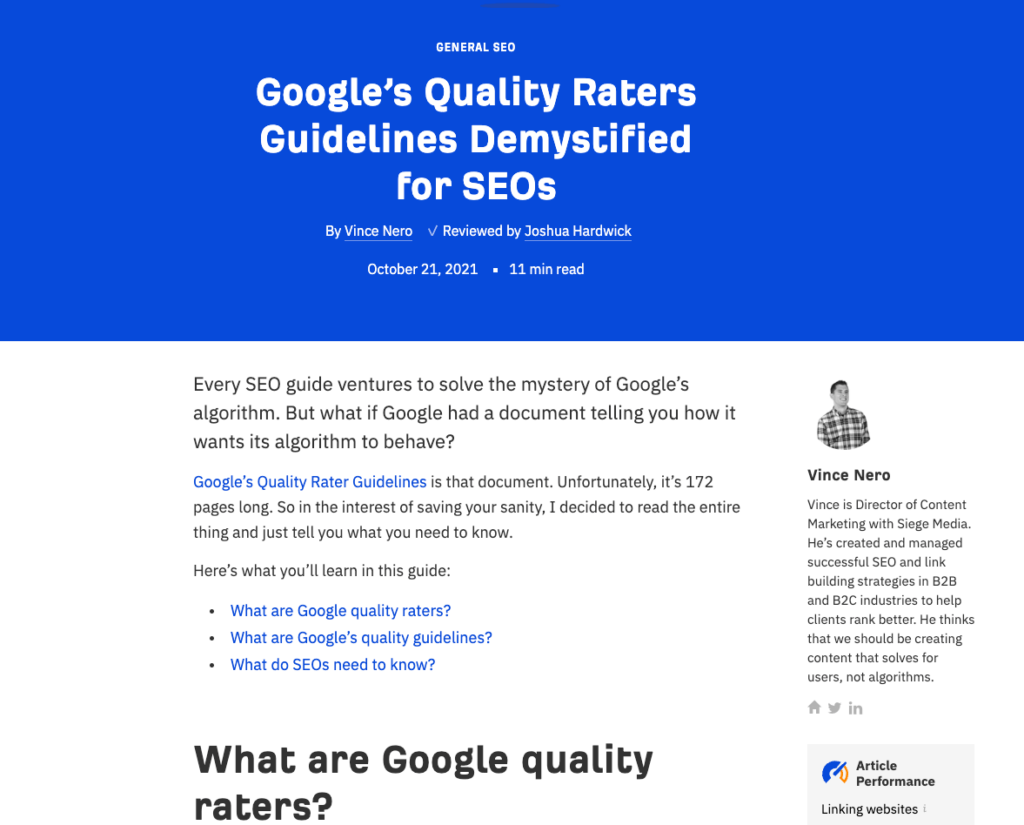
In other cases, you can add a link within the post itself.
For example, here is a guest blogging placement I did years ago for Page One Power.
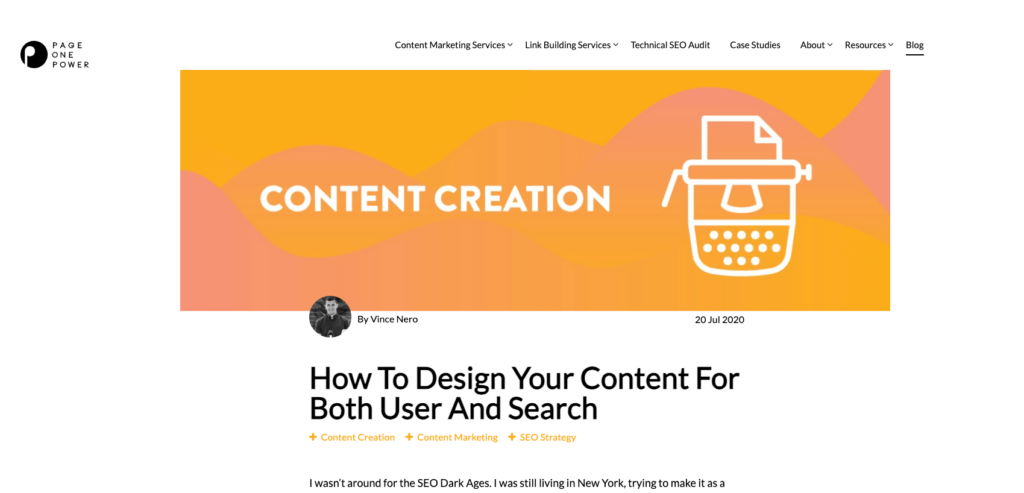
Rather than a link to the generic home page, I mentioned a post I wrote for Siege Media.
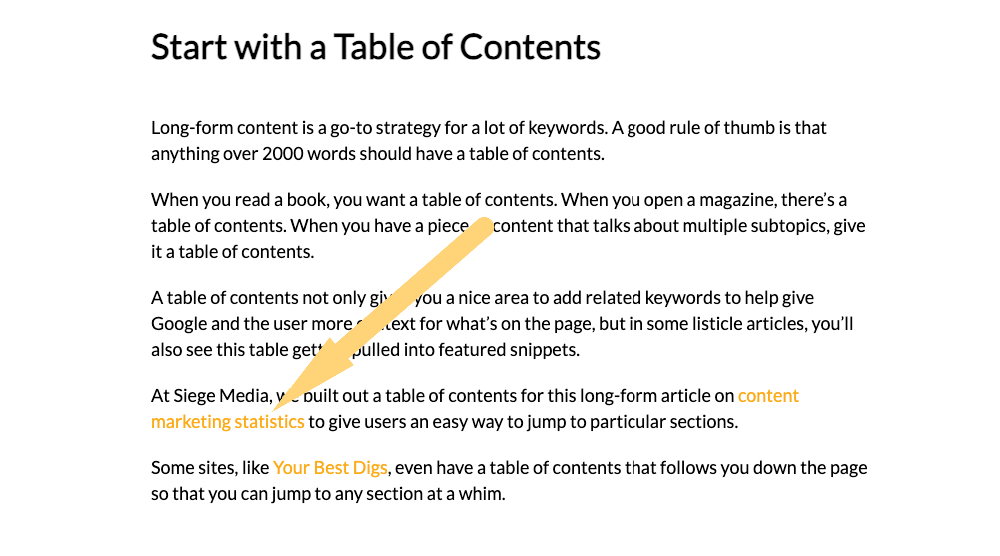
Since you can typically add a link within the content, guest blogging has become a common link building strategy for SEOs.
In the next section of this post, I’ll explain how to think about guest blogging as a content creator rather than a link builder.
Step 1: Find Guest Posting Targets
The most important thing to remember with guest blogging is relevancy. Building relevant links is a shortcut to building authority.
So, let’s start by finding relevant sites that have a blog.
The easiest place to start is by looking at the sites that want guest contributors.
1. Sites Who Want Guest Contributors
The best way to find these kinds of sites is via a Google search for your industry + the following terms:
- Write for us
- Contribute
- Guest article
For instance, say I owned a boat rental site and I wanted to find guest blogging sites in the fishing industry, you might search for:
“Fishing + write for us”
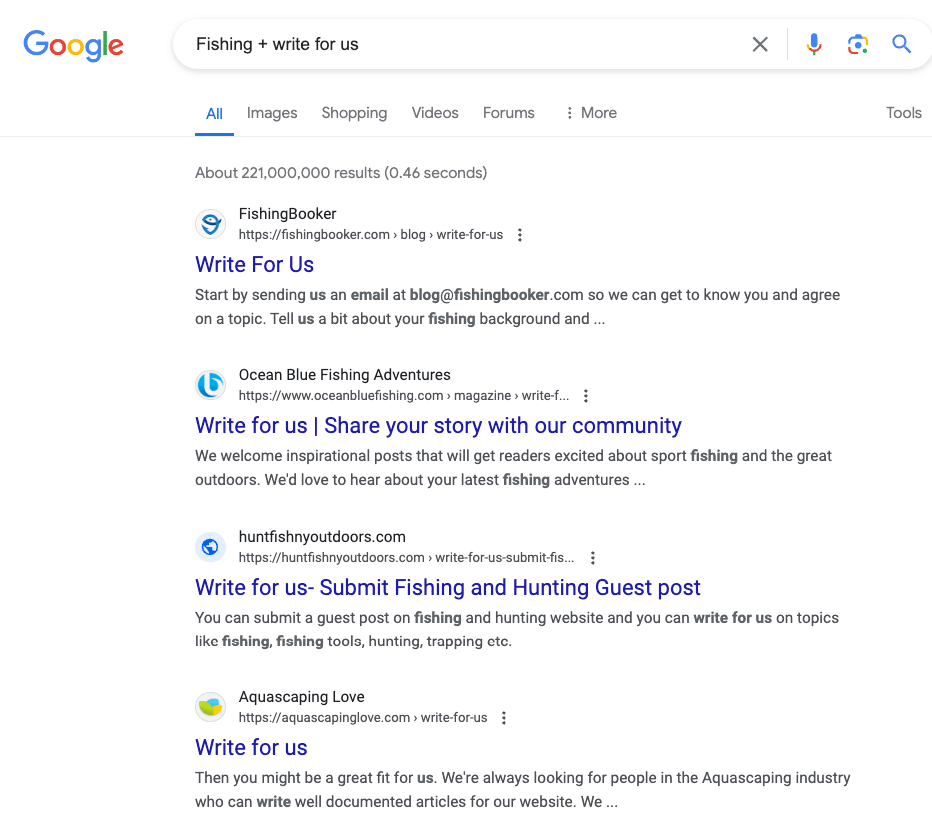
It’s worth mentioning that some risk is involved in sites that overtly mention they offer guest post placements if your goal is link building.
Risk 1: If anyone can contribute, the link will be worth less overall. Even with the very strict writer guidelines, the gates are still open to anyone, which makes it less likely to be very valuable, even if it’s a high-authority site.
In our podcast with Linkpitch.io’s Aaron Anderson, he recommends avoiding sites that blatantly advertise the links. Here’s his take:
“If they’re being very blatant, if it’s like from every page, you see the write for us page, generally speaking, I would say that that’s a bad sign… but having a contributor page or write for us page isn’t necessarily a negative.”
Risk 2: The more significant risk is that most sites offering guest posts exist only to make money. These sites carry a risk, which I’ll get into in Step 2.
If you want to avoid the risk altogether, you can try to find sites that don’t overtly offer guest bloggers or guest contributors.
2. Sites That Have Blogs In Your Industry
The cleanest way to get a link into a post through guest blogging is by avoiding the sites that openly advertise working with guest bloggers.
Instead, look for relevant sites that simply have blogs. So, you can do a Google search for something like industry + “blog,” articles,” or “resources.”
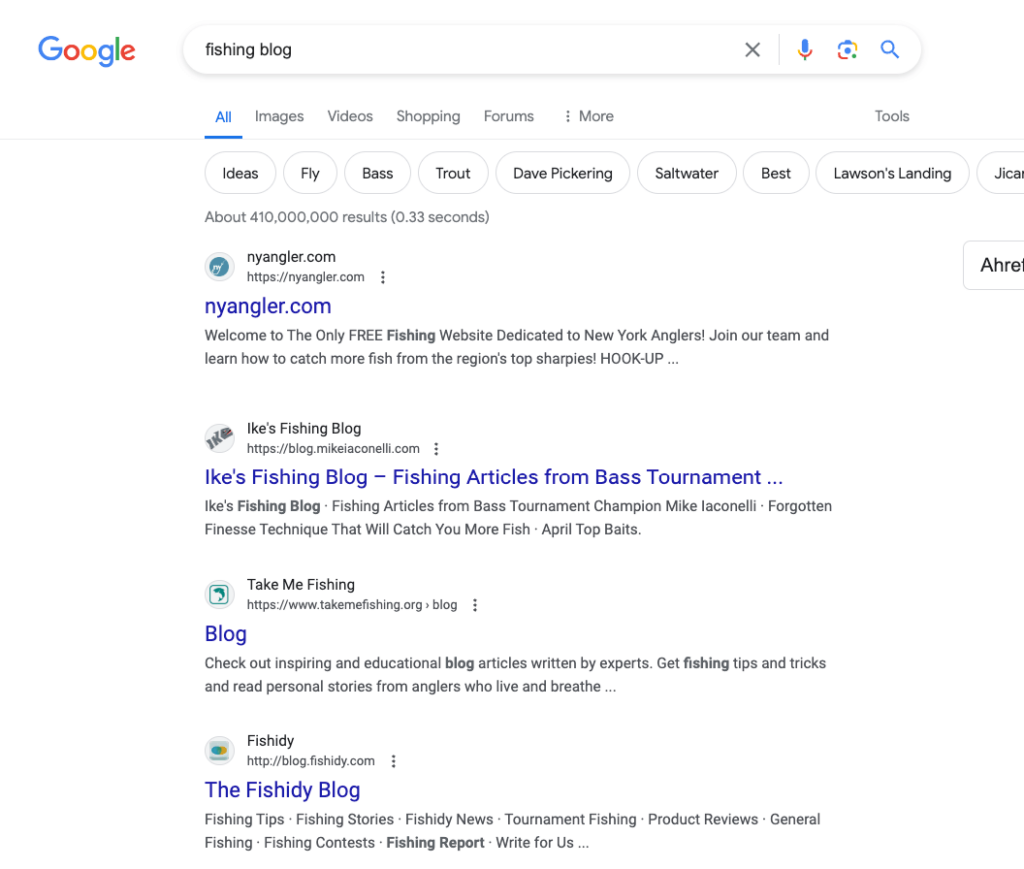
Based on our previous example of the fishing industry, I already found several new blogs.
Not all of these sites will be open to guest contributors, but if you jump down to step 3, I’ll show you how to drastically increase the value of your guest post offer and thus increase the potential of you getting a link placed.
Finding Sites Using BuzzStream
The benefit of using BuzzStream to find sites or prospects is that you can search multiple Google queries simultaneously.
First, I need to set up a new project and name it.
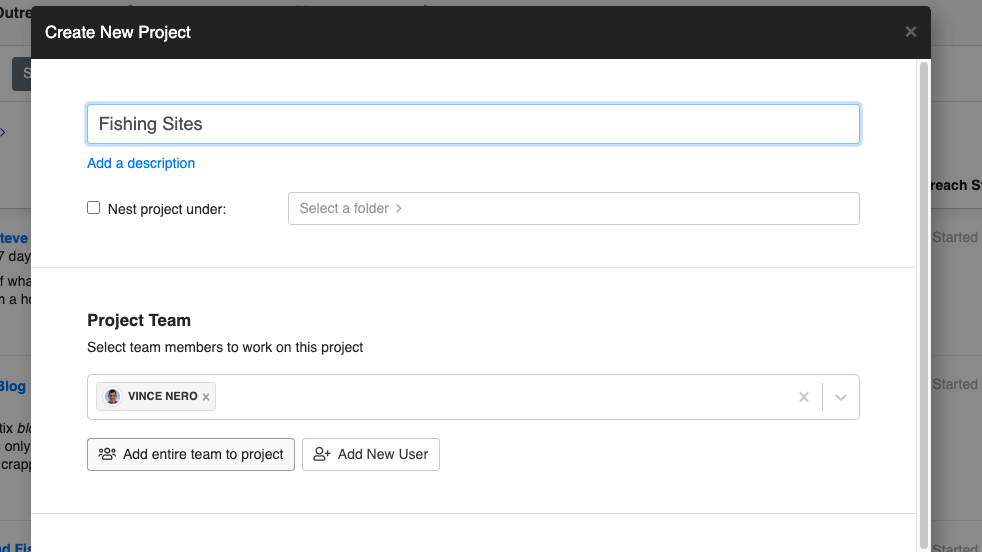
Then, I’ll scroll down to enable some Research Metrics.
Since I have Ahrefs synced to BuzzStream, I can pull in Domain Rating, Position Metrics, and backlinks.
All of these will be integral to helping me weed out low-quality sites in Step 2.
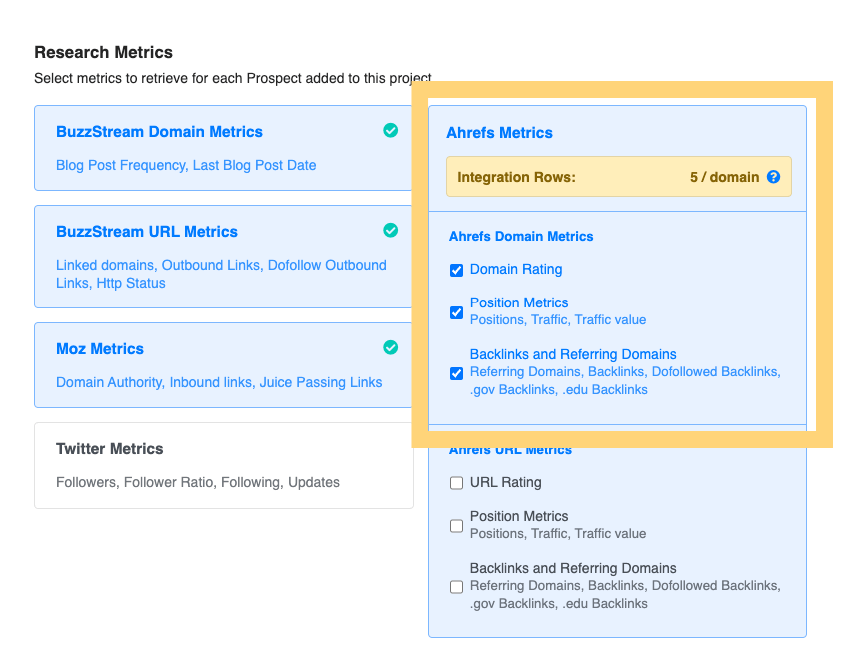
For instance, if I wanted to start a new Research List using BuzzStream, I’d start a New Project, name it, and then choose Search the Web.
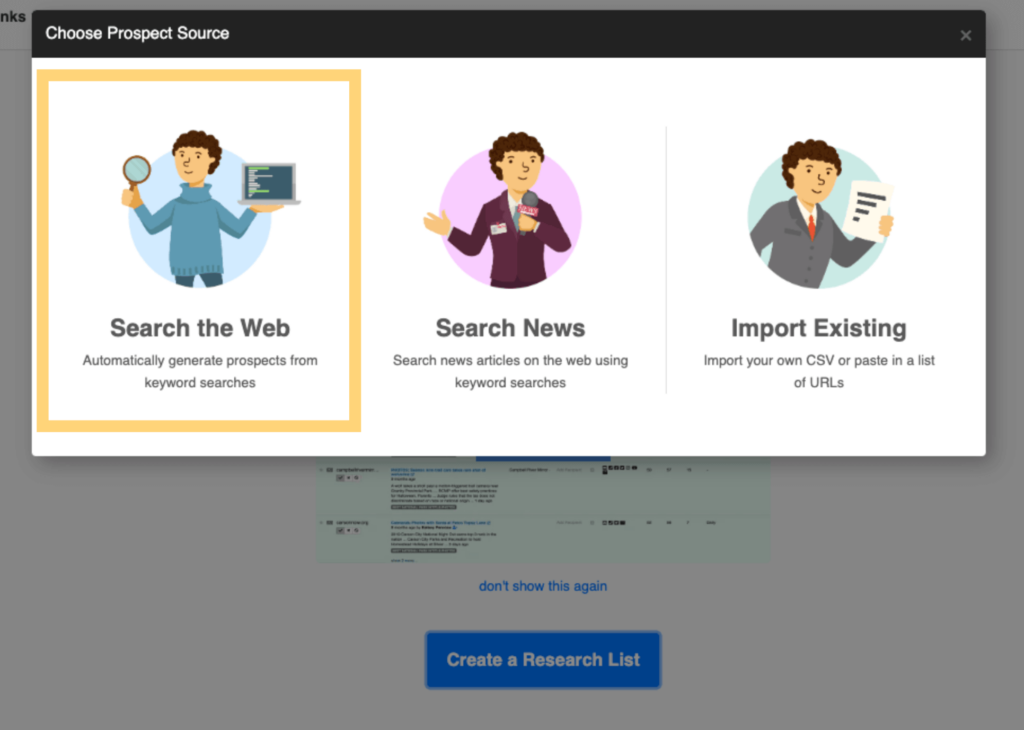
Then, I add my search queries to pull in all target sites.
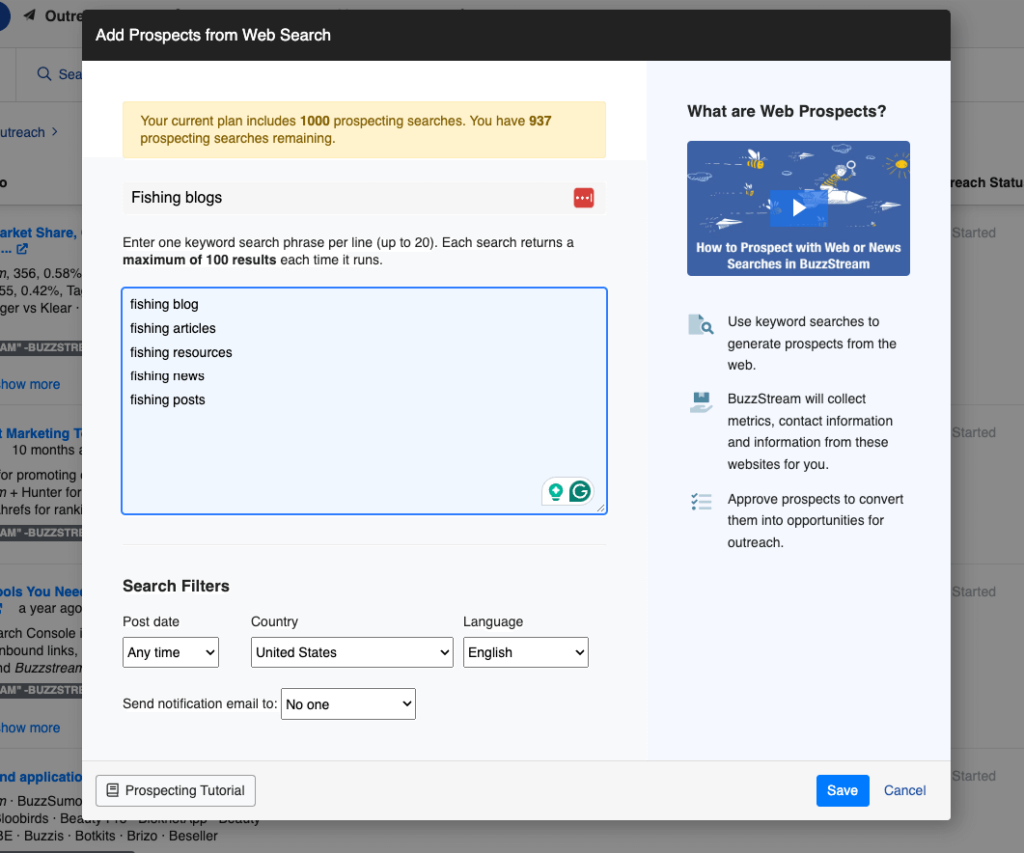
This will pull in hundreds of results that I’ll then narrow down for quality in Step 2.
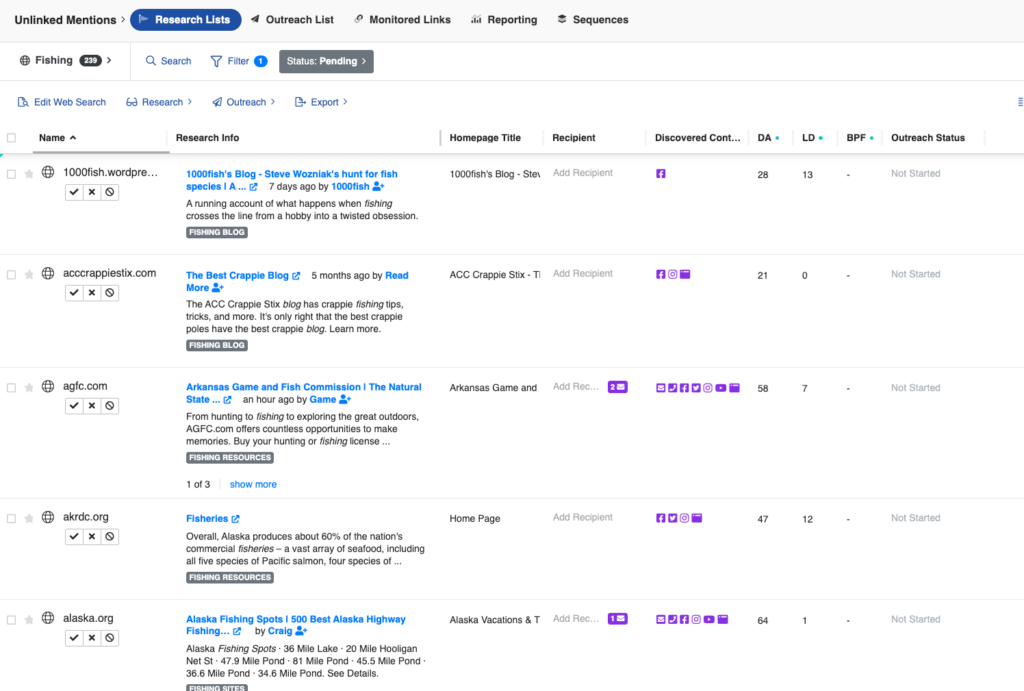
Now we can start the evaluation process.
Step 2: Evaluate for Quality
If you want a shortcut to quality guest posting sites, I evaluated the top-ranking guest post sites’ lists of over 800 sites and ran a quality check.
Ultimately, I identified 165+ high-quality guest posting sites.
I already did a video and post on this, which you can find below.

But here are some of the quality checks you should do on your site.
Do They Advertise the Price for a Post?
Any buying and selling of link placements for ranking purposes (i.e., without nofollow, sponsored tags) is technically against Google’s guidelines and will be marked as spam.
So, while this isn’t a “quality” check, a site that accepts guest posts for money and clearly advertises this on their site is essentially a nonstarter for me.
Google has the technology to find patterns and signals determining whether a link is bought or sold. As recently as 2022, Google announced that it is using its AI-powered SpamBrain to detect and devalue sites participating in these link practices.
What clearer signal than publishing the cost of a link placement?
For example, I would stay away from a site like this:
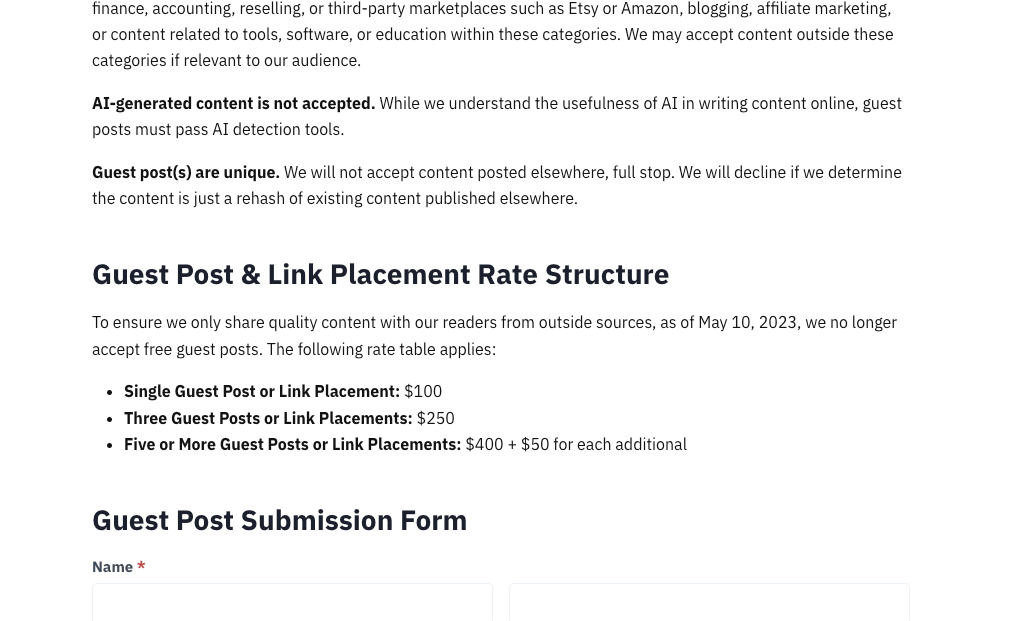
(Thanks to Geoffrey Archer for his help finding this page example.)
Are sites that accept guest posts for money but don’t advertise them still at risk?
This is where it gets a little hazy.
I mentioned this in Step 1. It is risky to get a guest post published on a site that exists only to make money from guest posts and link insertions.
You’ll often reach out to a site that doesn’t advertise a price, and then you get a response like this:
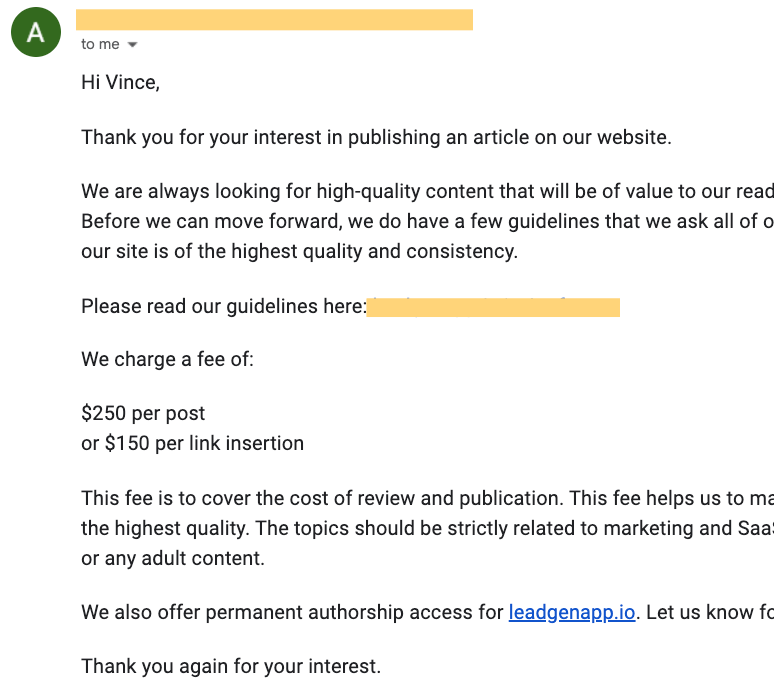
But if the site isn’t advertising, how would Google even know?
Brian Dean discussed this problem in our podcast. He referred to these sites as ones that could get you into a “bad neighborhood.” (Check out the recording at around the 7-minute mark.)
“Also, if you can just buy a link from a site, then anyone can. So those domains tend to get degraded over time if they aren’t already.
So what happens is a lot of times they’re like, no gambling, crypto, CBD, blah, to make it seem kind of legit. And then they eventually allow like a borderline one and then it’s a free for all.
And then your link is all of a sudden goes from like, Oh, this is really nice link to like on a spammy site with bad neighborhoods as I used to call it.”
An obvious signal is when a site can be found on a list, like a Google Sheet, that someone offers you, you should avoid it.
I mentioned in the intro that I receive lists like the one below from agencies almost daily (note that this is a different list, yet equally as sketchy):
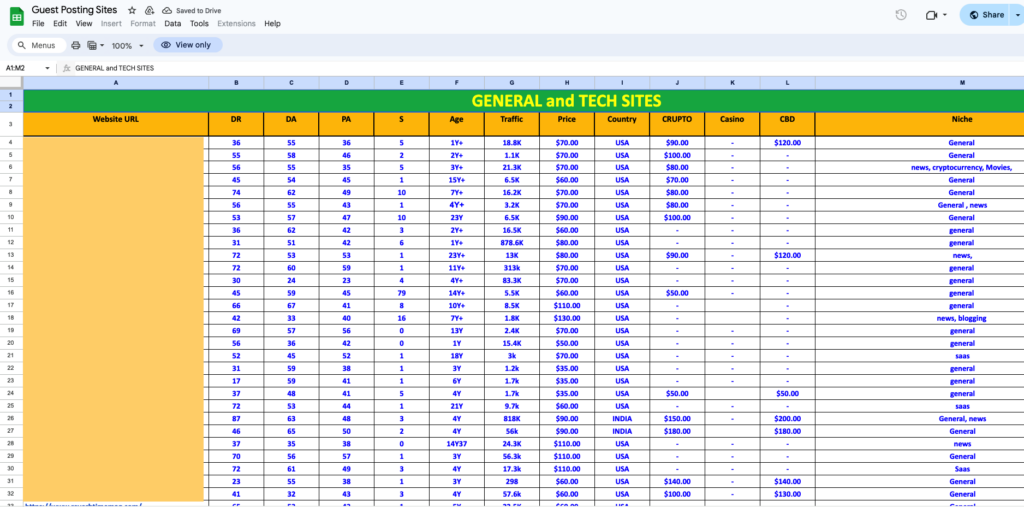
The sites truly doing this incognito may be less risky than others.
I haven’t seen any compelling study or data to tell me one way or another, but the evidence in favor of avoiding these kinds of sites is mounting.
Let’s move on to other checks like traffic or authority with that out of the way.
Traffic Above 5,000 Organic Searches Per Month
I set the bar at 5k monthly searches in my guest post site analysis. Essentially, the higher you set the bar, the fewer sites you’ll find. I might sometimes go even higher, like 10k, but for our purposes let’s stick with 5k.
Use a tool like Ahrefs’ Site Explorer to see the actual organic traffic.
Enter the domain, and look below at the Traffic value under “Organic search.”
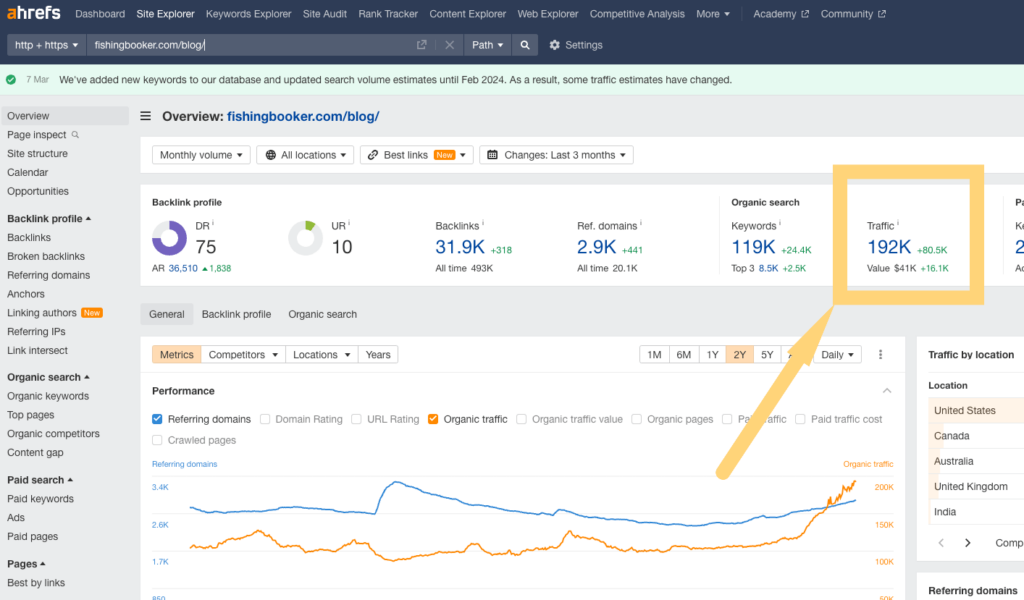
This isn’t foolproof because a site with overall traffic doesn’t mean the page you write will get any traffic. But it’s a good starting point.
Domain Authority or Domain Rating Above 50
Authority metrics like Domain Authority (DA from Moz) or Domain Rating (DR from Ahrefs) help give some directional sense for whether or not a page can rank for keywords in Google’s eyes.
So, getting a link from a higher authority site typically sends more value.
You can check DR using Ahrefs’ Site Explorer as well. You’ll find it under Backlink Profile.
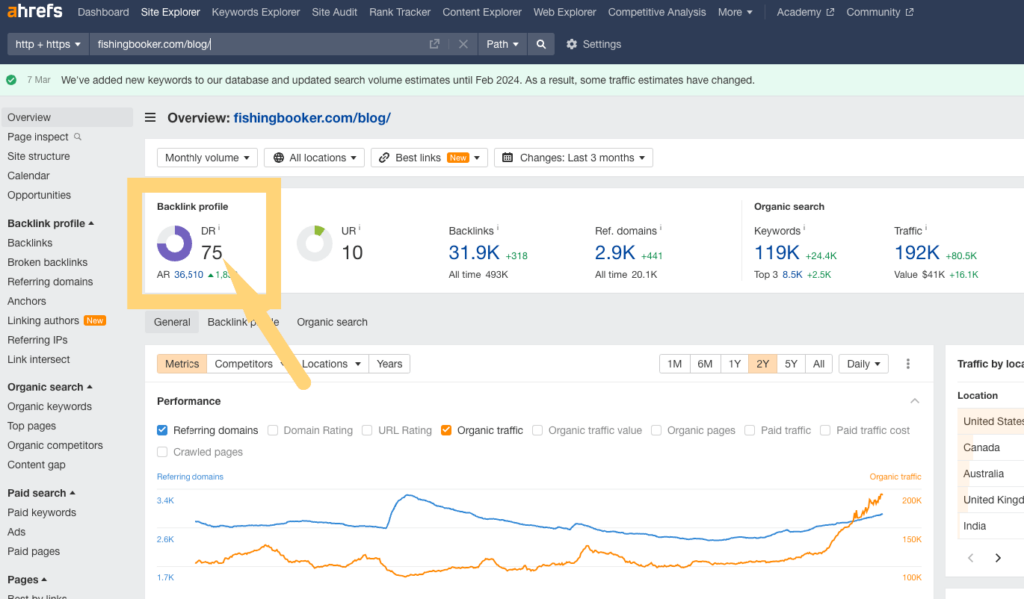
Just because a site has a high Domain Rating doesn’t mean it’s necessarily high quality. You still need to evaluate some of the relevancy and content quality.
Content is Relevant To Your Site
Content relevancy is critical to a successful guest blogging campaign. Getting links from irrelevant sites will not help your case.
Think about it: even if your goal is just brand awareness or establishing yourself as a thought leader, if you are doing so in the wrong industry, you aren’t going to get much value out of it.
So why waste the time?
A quick way to determine if your target site overlaps your industry is to evaluate the top-ranking keywords to determine their topical authority.
For example, if I were evaluating the fishing blog, I’d head to Ahrefs’ Site Explorer and, on the left navigation, choose Organic Keywords.
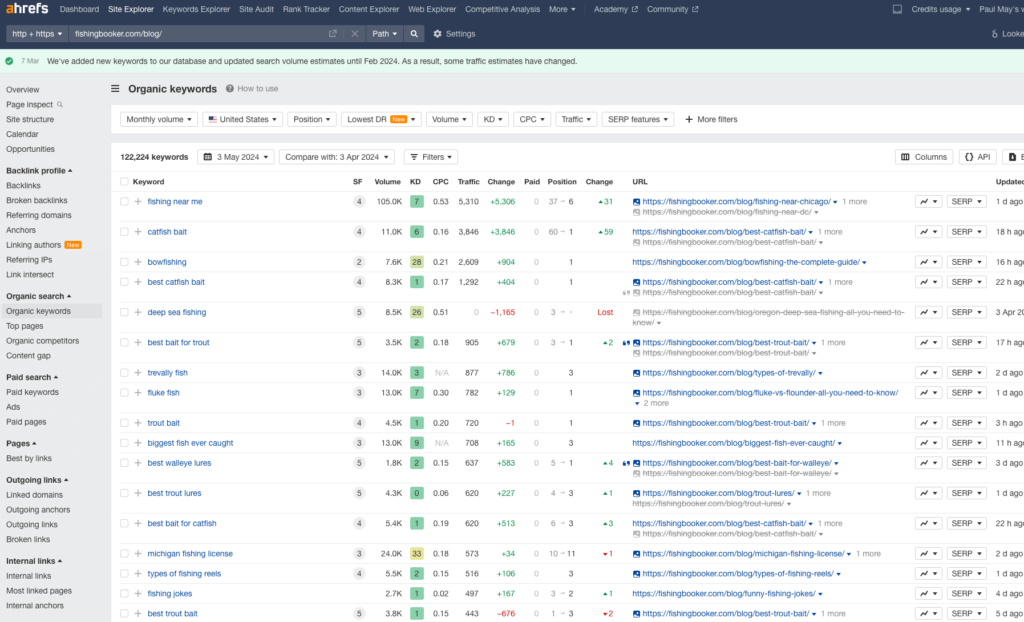
Many fishing-related keywords rank well, telling me they are an authority in fishing.
It would make sense for a boat rental site to get a link from a fishing site. (You use boats to catch fish, and they rank for fishing keywords.)
You always want to search keywords in the top 5 or 10 positions.
FishingBooker ranks in the top 10 for all of these keywords.
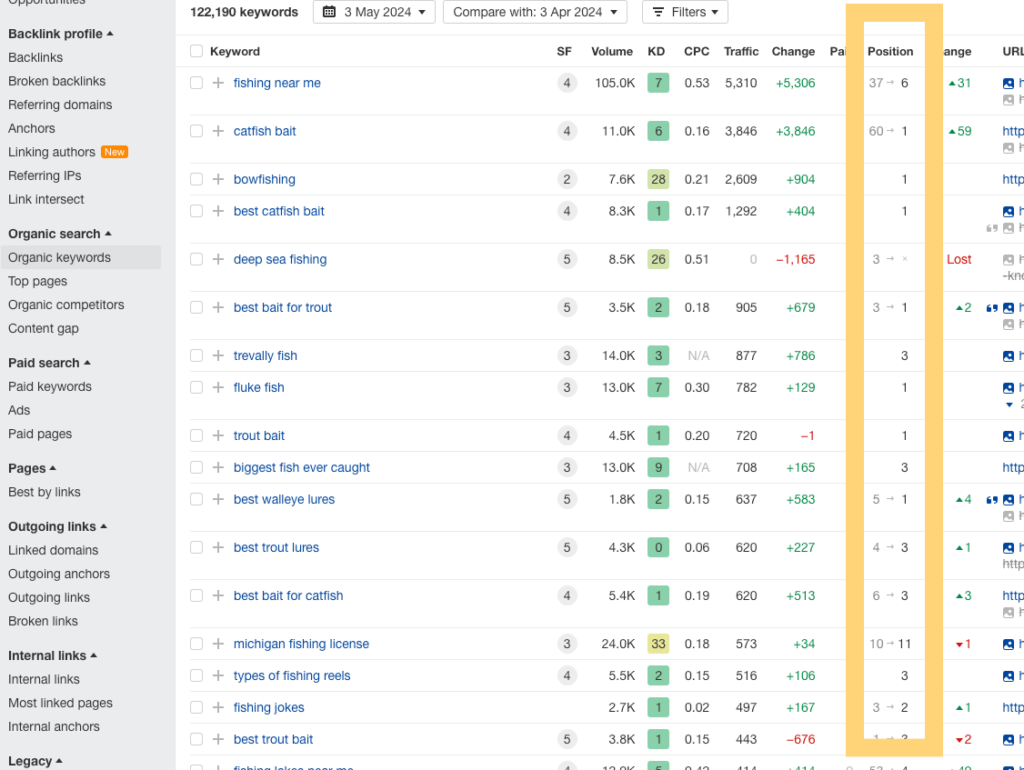
I realized that this example is relatively straightforward, so let’s examine a type of guest post site I see a lot on the web: general news sites.
For example, the site below, DailyGenius, covers education, tech, business, lifestyle, health, and “general” topics.

So, when evaluating these for topical authority and relevancy, I’d try to look more at the keywords on the vertical or category level vs the site overall.
Regarding our boating rental site, we can argue that travel is a relevant industry (you might rent a boat to travel).
So, let’s examine Daily Genius’ travel section to see if it has any topical authority.
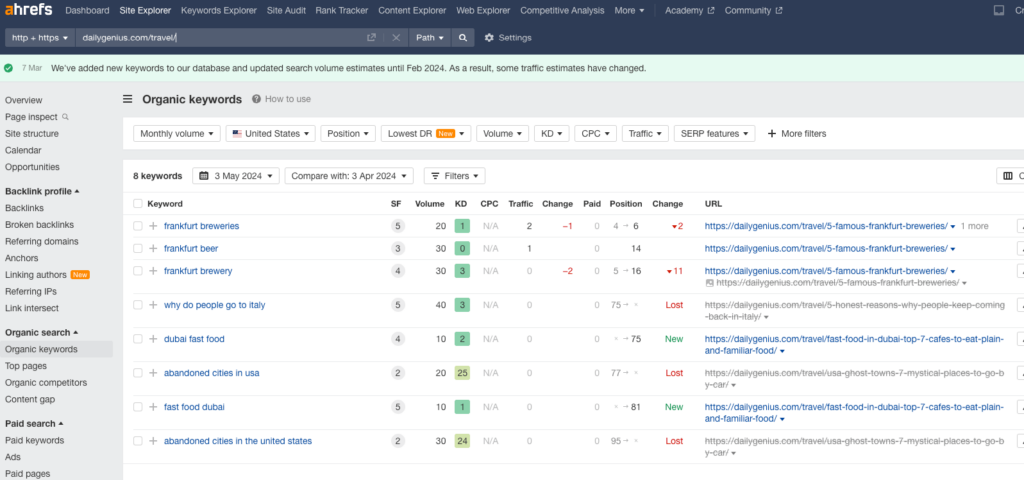
I only see eight keywords with no discernible focus, and only one page ranks in the top 10.
So, to me, this page has no strong topical authority and isn’t relevant to boat rentals.
But, even if the site’s overall content is relevant, it’s essential to evaluate it based on Google’s Helpful Content recommendations.
Site Provides Helpful Content
In March 2024, Google rolled out a massive algorithm update, solidifying Helpful Content into their ranking systems.
They’ve provided a helpful checklist for content creators to use to evaluate their own content and determine whether it’s “helpful.”
We’ve summed this up in a helpful document:
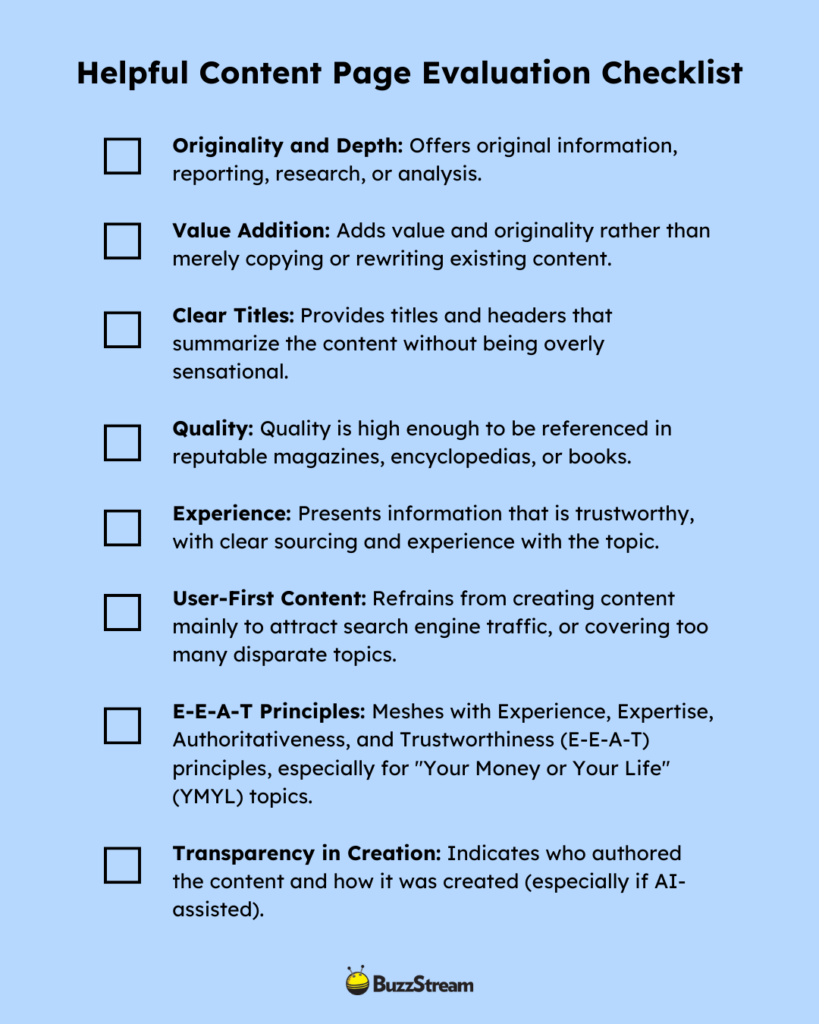
To summarize, what you are looking for is truly quality content.
I like to look for proper sourcing of information, whether or not the author talks about doing the thing they are writing about, and original data.
For example, here is a post from Fishingbooker about getting a fishing license in Nebraska. It has abundant helpful information, such as the costs for permits.
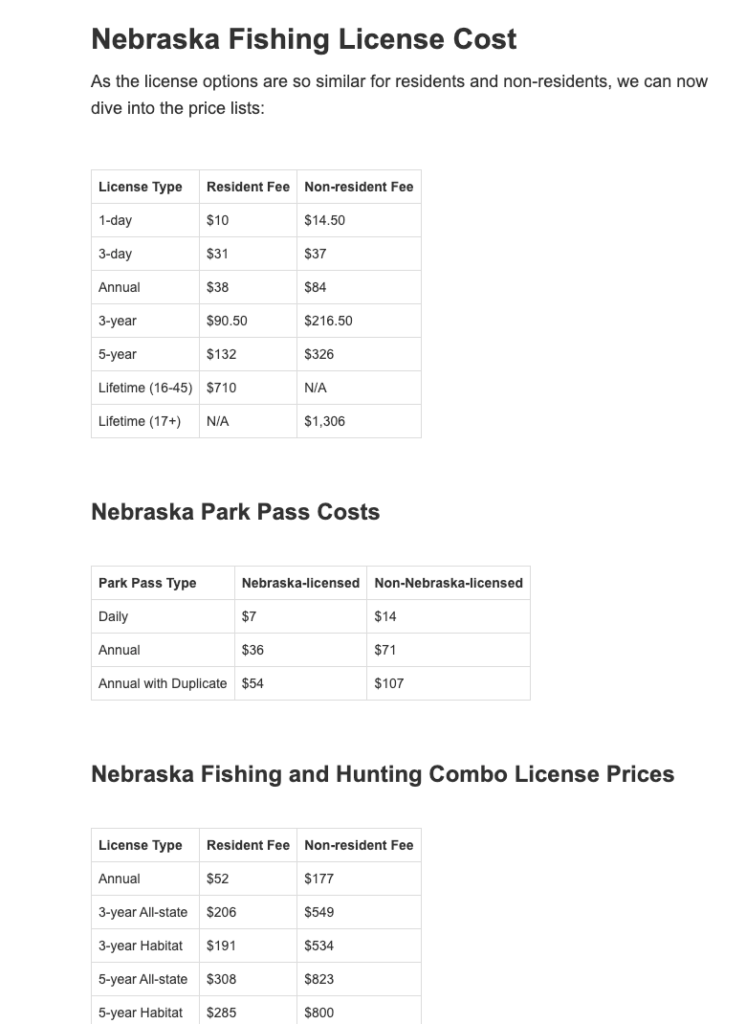
And—one of the more accessible signals to discern— it clearly shows that the author knows about fishing:
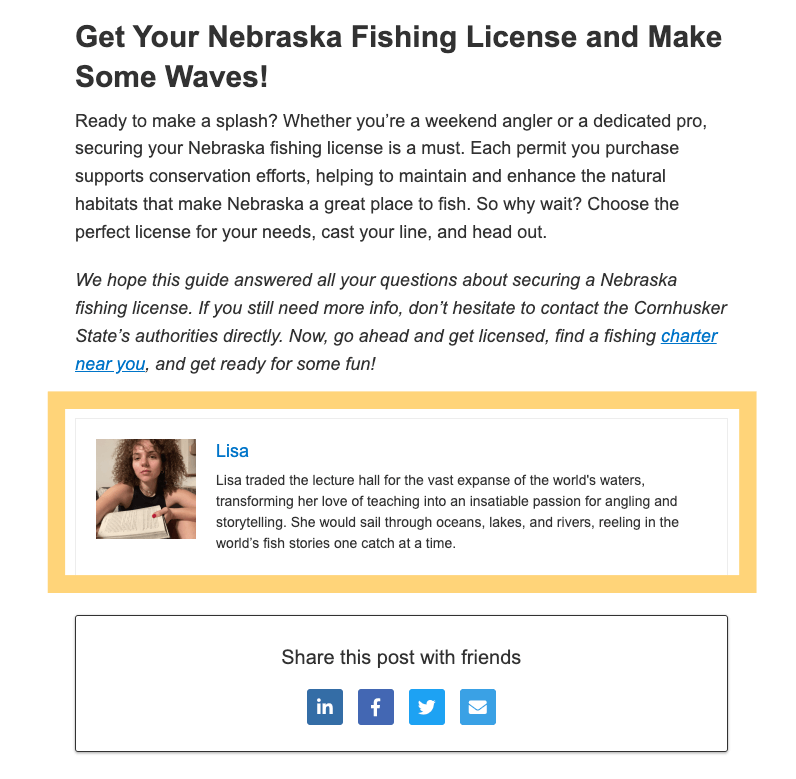
For comparison, I found a low-ranking post about restaurant equipment:
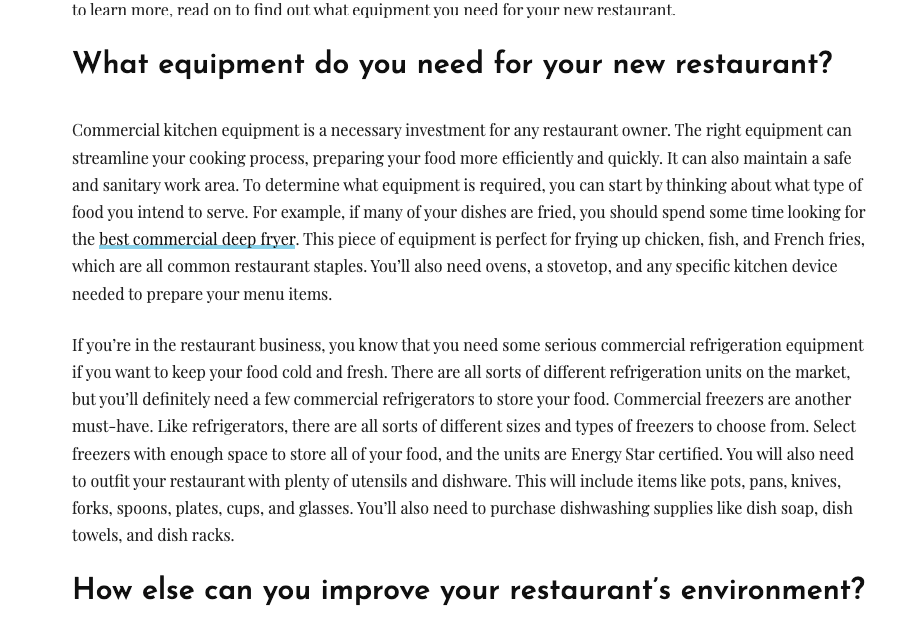
The only external link is to a product page (clearly trying to rank for deep fryer.) I see a wall of text with no photos of the equipment.
Lastly, I don’t see an author, so I don’t know who wrote this or if they ever worked in a restaurant kitchen.
I can go on, but you get the picture.
Is this a time-consuming process?
Yes, but it gets faster as you do it.
Plus, it’s way more effective than brute-force link building. Google has even said that one link from a highly relevant, quality site can be worth more than hundreds of others —something I discuss a lot in our post about the quality of a link.)
Do They Have NoFollow Links?
This one is simple.
Google views purchased link placements as advertisements, requiring tagging with rel=nofollow, sponsored. Technically, Google doesn’t pass value from a nofollow link.
This prevents sites from scaling link building schemes.
I should note that nofollow links do provide indirect value. If you get a link or article from Forbes, there’s a good chance that people will see it. When people see it, they are likelier to click on it and visit your site.
Thus, nofollow links can provide direct traffic and general brand awareness. So, if that is your goal for guest blogging, then you don’t have to worry about nofollow vs follow links.
But if you want to build a link building campaign from nofollow links, you’ll find little to no value there.
Filtering For Quality With BuzzStream
Once a Research List is compiled in BuzzStream, it pulls in metrics and contact information.
I can filter the contacts relevant to my guest post outreach using these features.
Remember when I added Ahrefs’ Metrics.
Well, look at the list it pulled in for me.
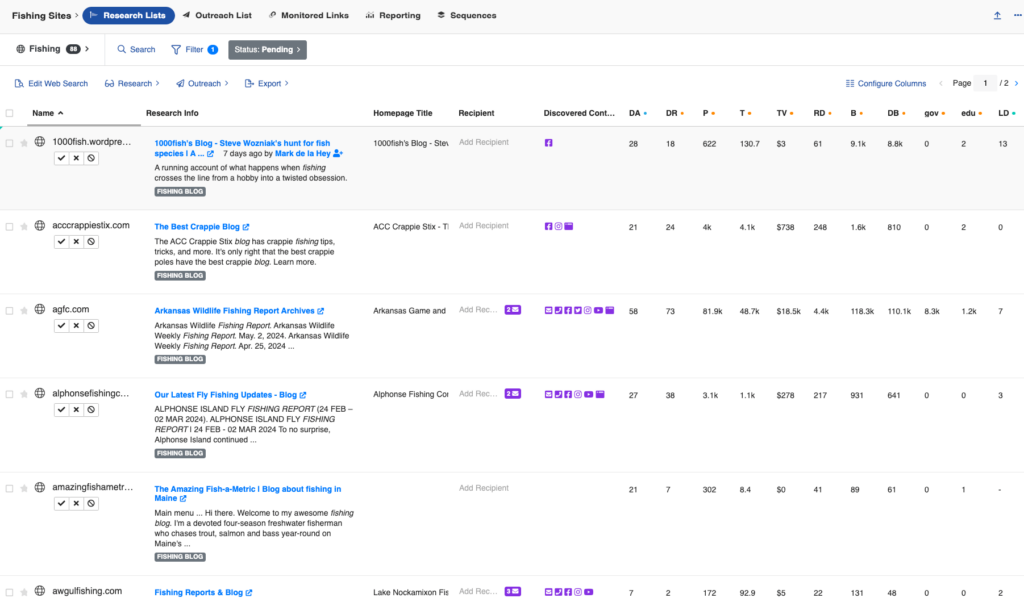
Now, I can use BuzzStream to help me qualify the sites based on the two previous qualities: organic traffic (T) and domain rating (DR).
First, I click Filter, then find my Ahrefs metrics under “Metrics.”
Then, I can filter out the low-quality sites by choosing DR >=25 and Traffic >=5000.
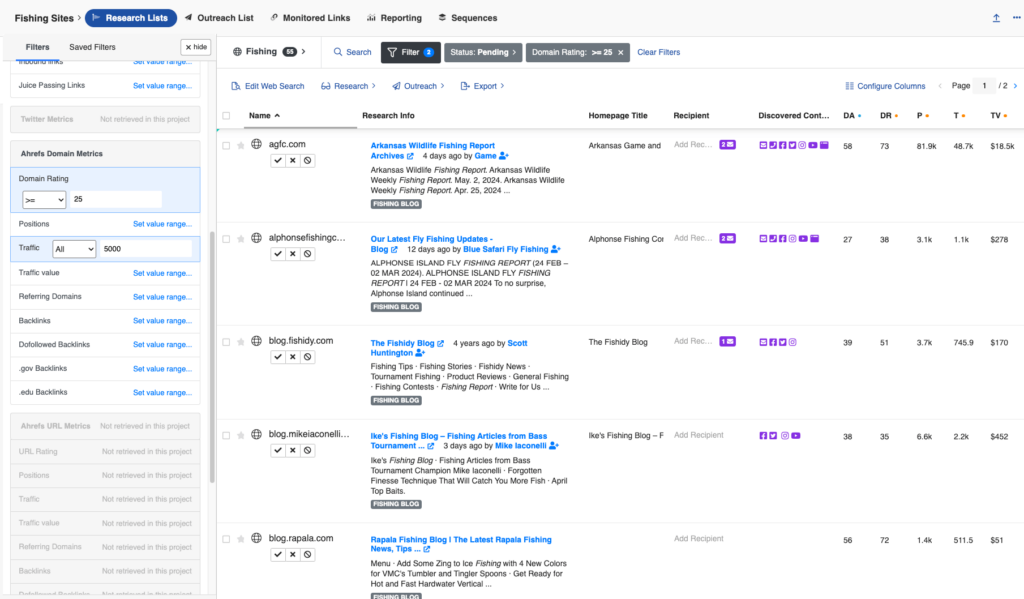
I can further filter down to include only sites whose contact information BuzzStream has found (which will be super helpful in step 5).
Now, I can use BuzzStream to comb through my list and evaluate the content on the page with the Research flow.
I click the Research drop-down and choose “Review on the Web.”
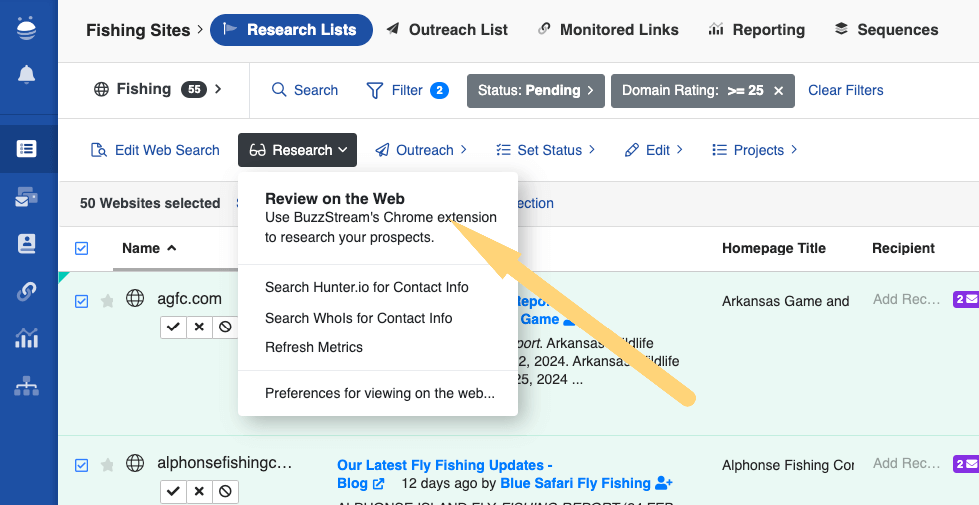
Select the default settings to comb through the sites 5 tabs per time. Now, I’m taken to BuzzStream’s Research flow, where I can evaluate the site for quality on the left and Approve and Reject it from my guest blog target list on the right.
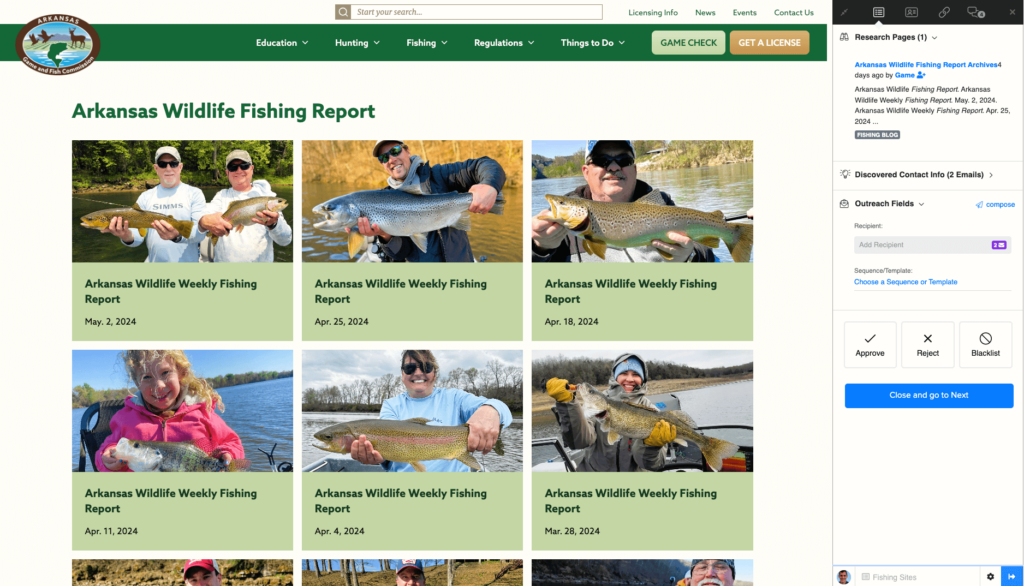
Once I choose Approve or Reject, BuzzStream opens up another tab in its place so that I can seamlessly move through my list without needing a thousand tabs open!
Now you know what to look for, let’s discuss how to find topics your targets want.
Step 3: Find Relevant Topics
Before we get started, here is a quick disclaimer: you must ensure you can provide experience and expertise for all your content choices below.
Ask yourself: Am I qualified to write a guest post on this topic? Am I bringing something new to the table?
These two qualities make and break writing these days—as evidenced by Google’s recent Helpful Content changes.
Ok, with that out of the way, let’s find topics.
The other day, I received a guest post request that pitched 25 article ideas.
None were related to BuzzStream, digital PR, or link building. (I’m also pretty sure they were all AI-generated.)
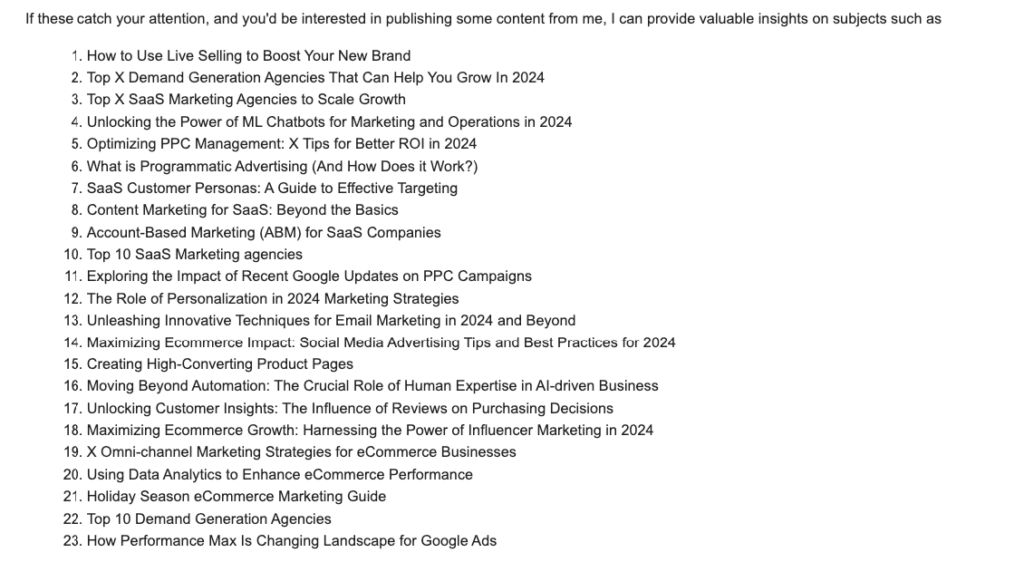
The approach will not work. To succeed with guest blogging, you need to think like a marketer—or, better yet, like an agency.
You are trying to sell your idea. So, you need to provide value to the site you are contacting.
Luckily, I have two killer tactics for you.
If you don’t have the time, I did a quicker video walkthrough here:

Below I’ll walk you through both tactics in more detail:
Tactic 1 – Keyword-Driven Approach
When trying to find a topic to pitch, the best thing you can do to get a guest blog idea accepted is to provide quantifiable value to your target.
The most straightforward way to provide value for most sites is to choose a keyword they should rank for but do not and offer to write that content for them.
This offers a quantifiable value (search volume and traffic value), making it harder for them to say no.
This approach requires knowledge of the site and content area.
Head to Ahrefs Site Explorer for this approach and evaluate the site’s current Organic Keywords.
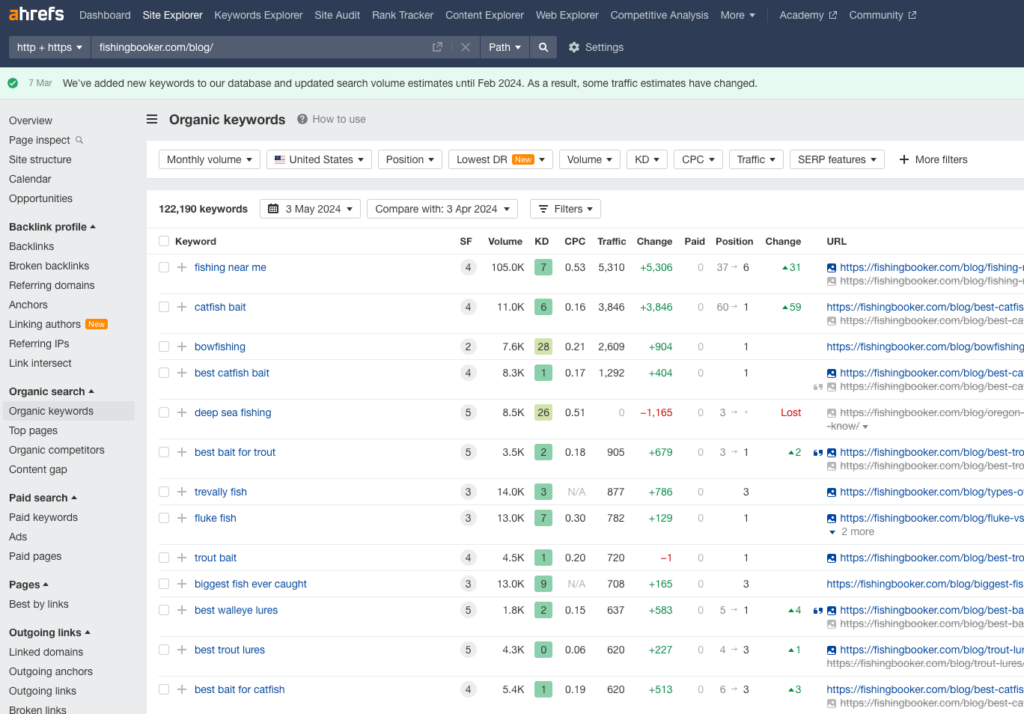
Then, let’s look at the keywords that aren’t ranking well. We can set the position to 30-100 and only examine lost or declined places.
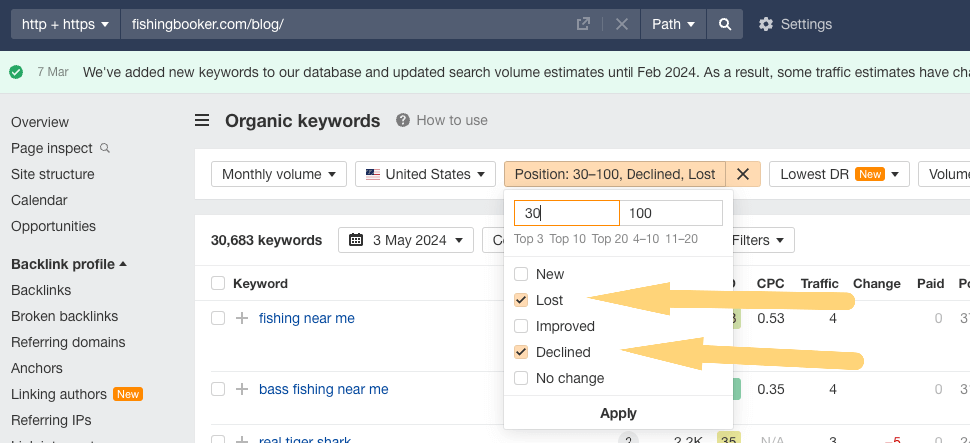
Now, we will look for keywords with no relevant content ranking.
I’ve found two that might work:
“How to set up a fishing pole,” and “How to hold a catfish.”
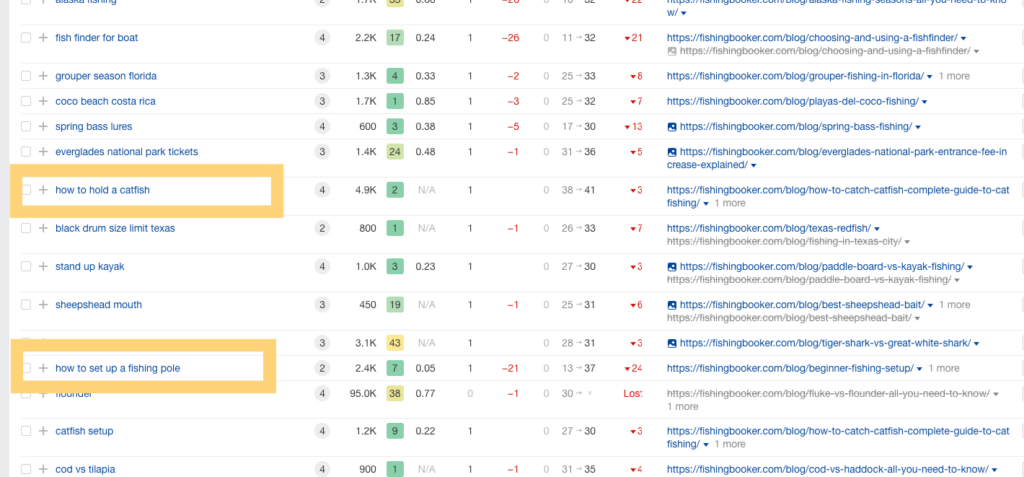
I want to ensure they can rank for these keywords, so I will look at the SERP for “how to set up a fishing pole.”
If I click on the keyword, I will be taken to the Keyword Overview page in Ahrefs. Then, I can scroll down to see the SERP overview.
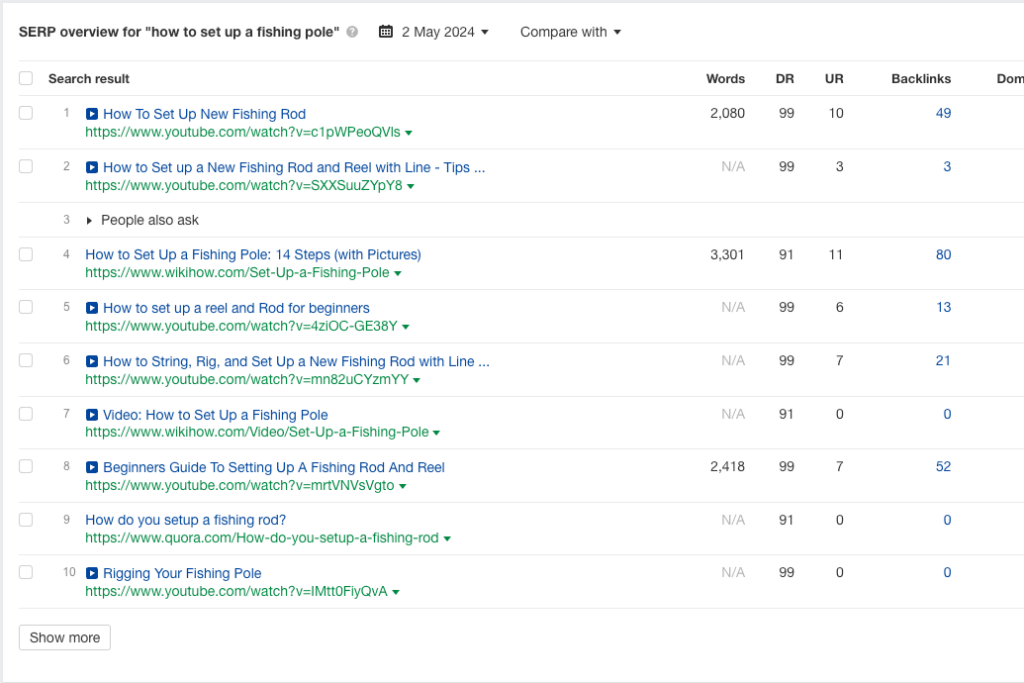
(Alternatively, you can just Google search “how to set up a fishing pole,” though you will get more localized results.)
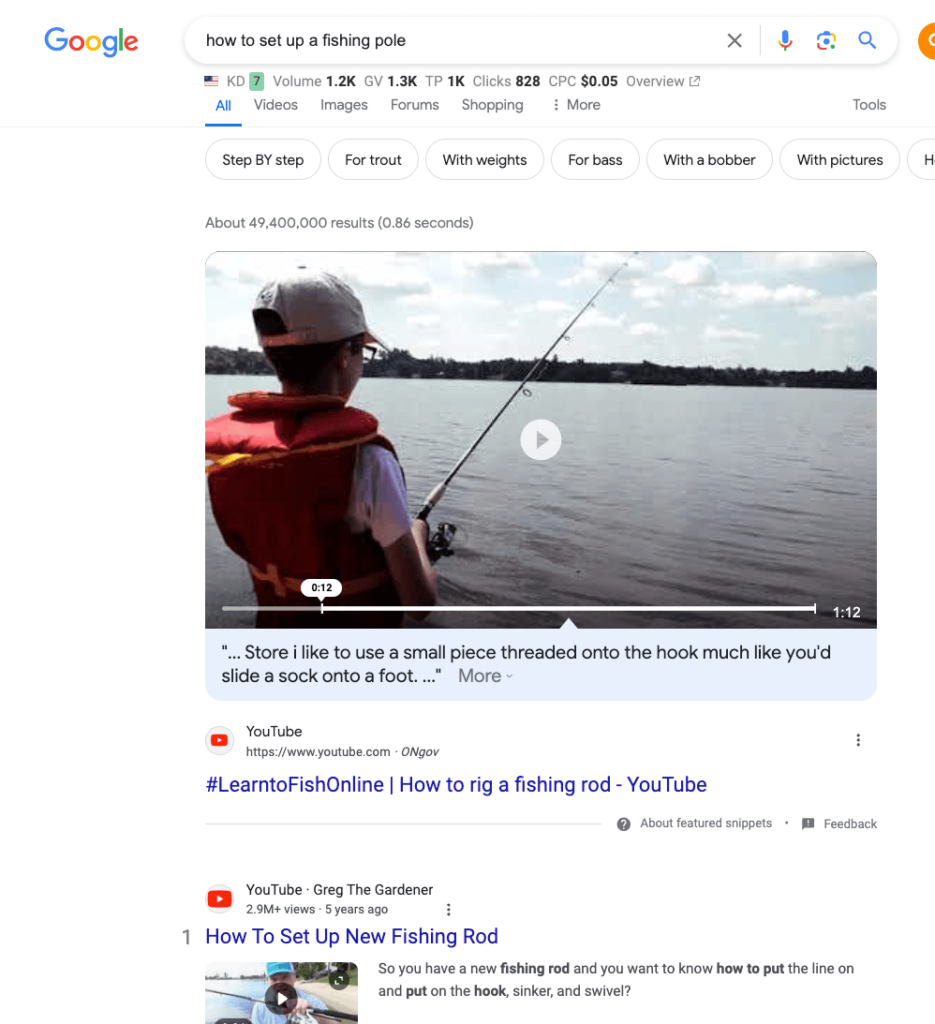
In both cases, this SERP includes virtually all YouTube videos. So, this topic wouldn’t be a good fit for a guest post.
Let’s check “How to hold a catfish.” The SERP for this query has a little more variance (although it still has videos ranking in the top 2 spots.)
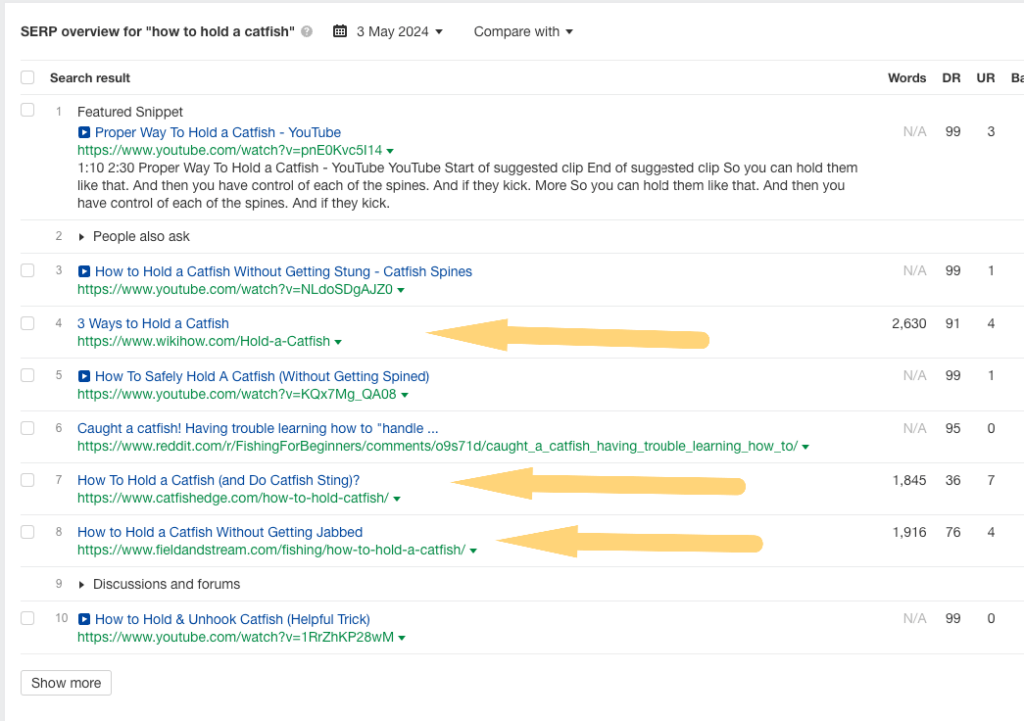
So, this could be a good keyword to choose and pitch to our target as a guest blog post.
When we pitch, we will focus on the organic traffic that this keyword could potentially bring in for them.
For this, you can look at the Traffic Potential metric.
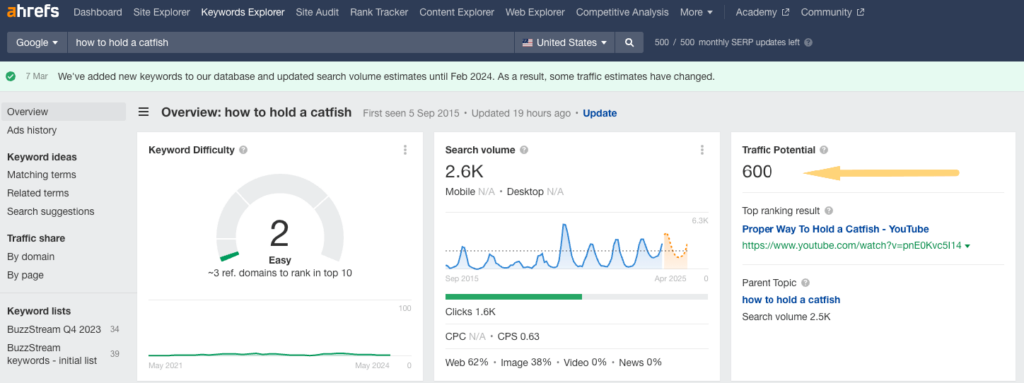
So, in our case, this keyword has a potential of 600 monthly searches.
This may be enough to convince them to choose this keyword. If so, you can proceed to step 6: drafting your email.
However, to maximize this keyword approach and find super valuable keywords, let’s look at this tactic more thoroughly.
Tactic 2 – Advanced Keyword-Driven Approach (Using Content Gap)
After working at an agency for six years, one thing was sure: companies (and clients) are driven by competition.
I could make a case for any SEO improvement or content idea by saying these seven words: “Your competition is doing this and winning.”
You can use Ahrefs’ Content Gap tool to show how your target site compares to the competition.
Find competitors with Ahrefs
Ahrefs’ Site Explorer tool has an “Organic Competitors” tool on the left sidebar.
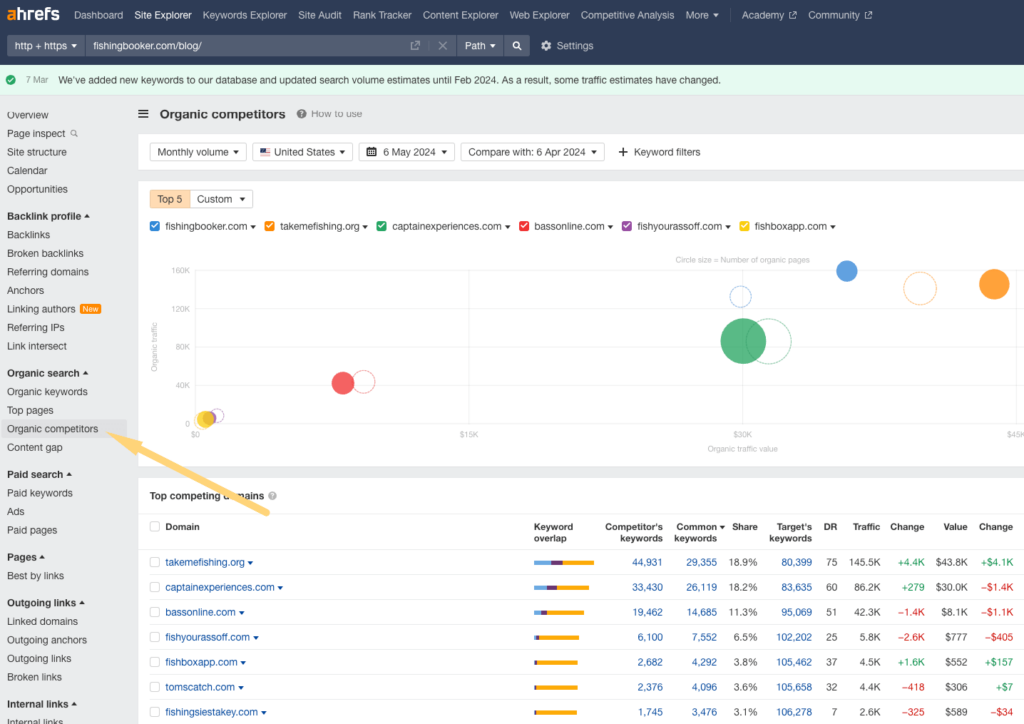
Click it, and you’ll see multiple sites whose keywords overlap with your target site. Focus on the sites whose DR is similar to your target site.
In the below, you can see sites like takemefishing.org, captainexperiences.com
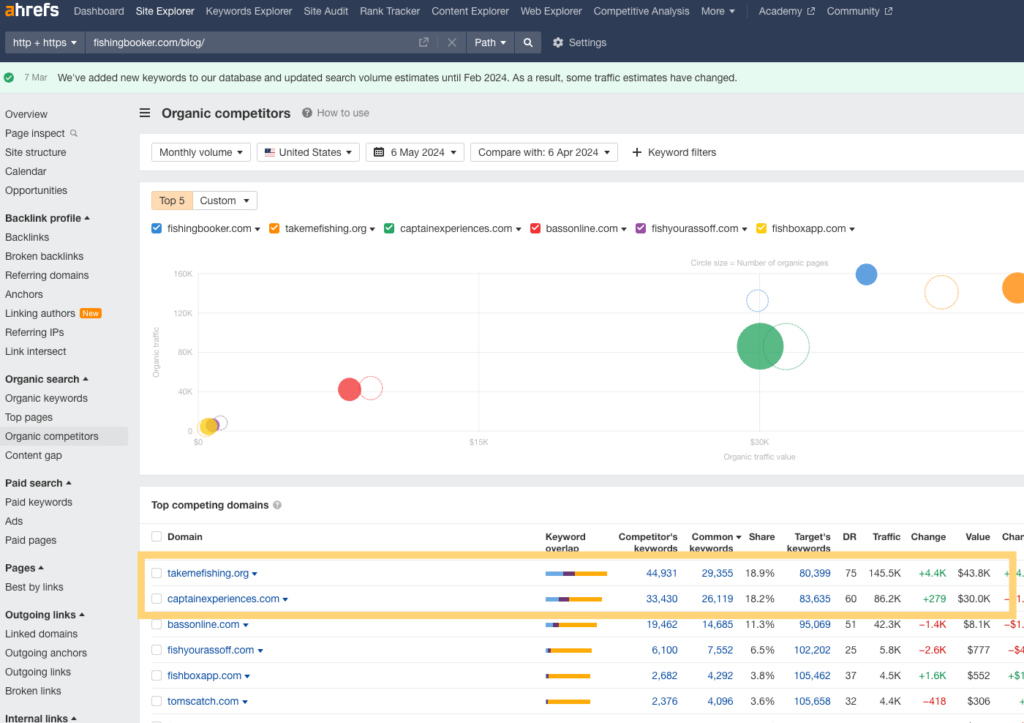
Select the two using the check box, then click Open in Content Gap:
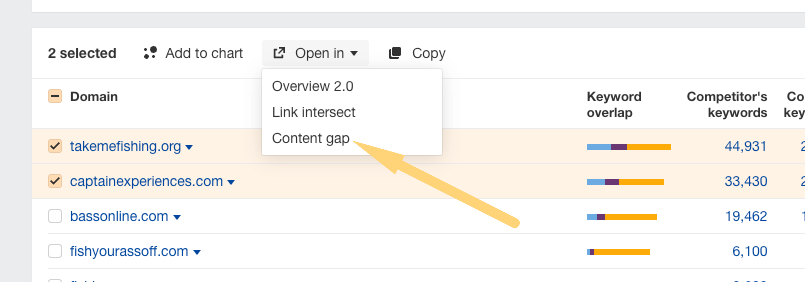
Now, you’ll see the Content Gap, which shows terms for which both sites rank but your target site does not.
Go to “All intersections” and select 2 (or if you have 3+ sites, select at least two intersections.)
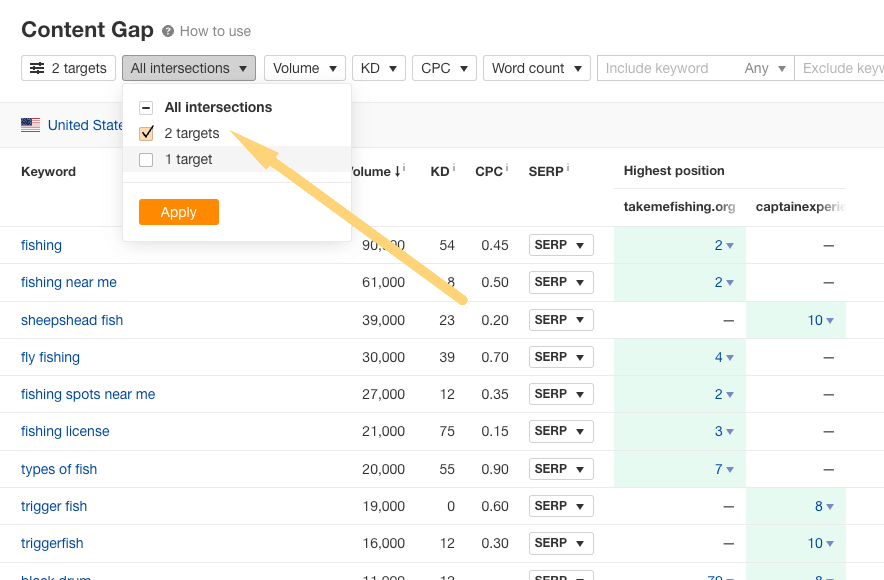
Now, you’ll see keywords for which the two main competitors rank, but the target site is not.
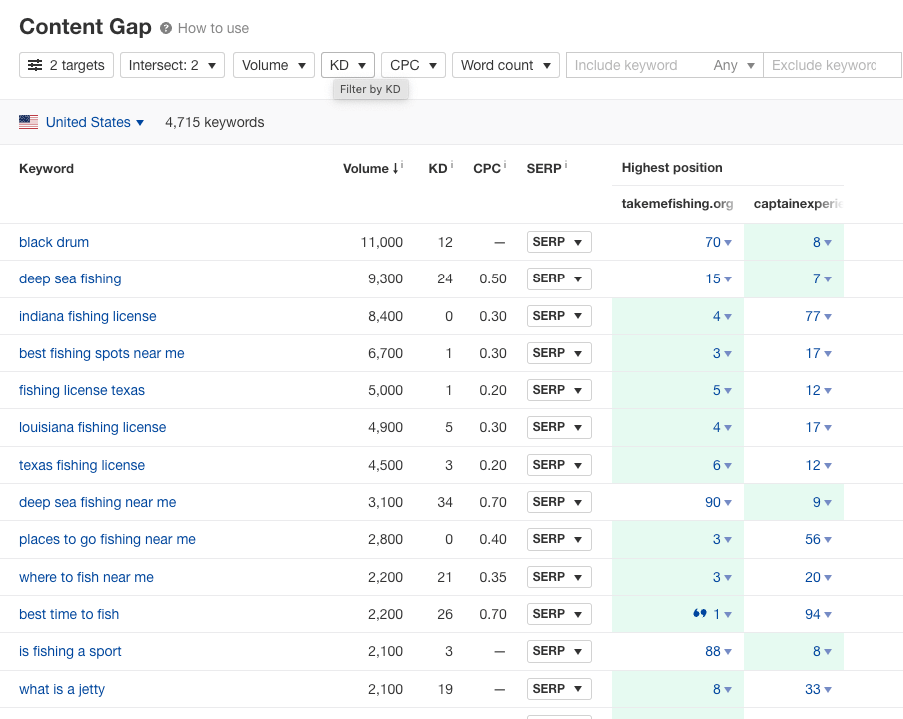
You are now looking for keywords where both competitors rank on page 1. This will tell you that this keyword is relevant enough for the target site and provide that FOMO to convince your target site.
I found “types of fishing,” with a KD of 26 and a monthly organic search volume of 1,900.
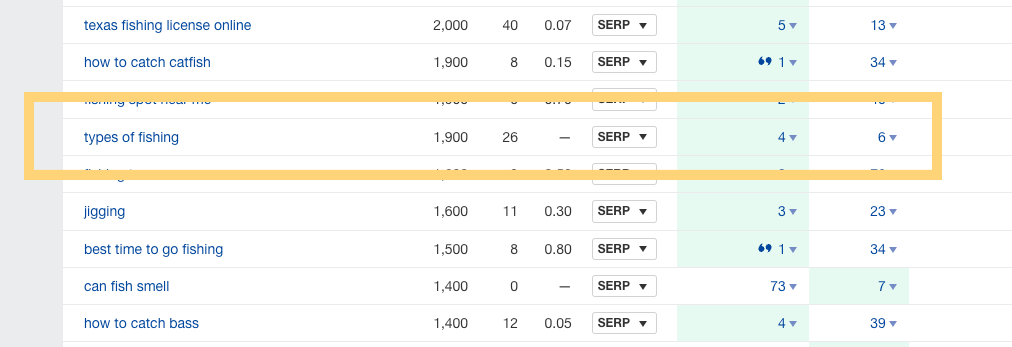
I still like to spot-check the site to ensure they don’t have a piece of content written for the term. (They might, but it may just need some updating.)
So, I Googled site:fishingbooker.com “types of fishing,” and found that they have what amounts to a hub page:
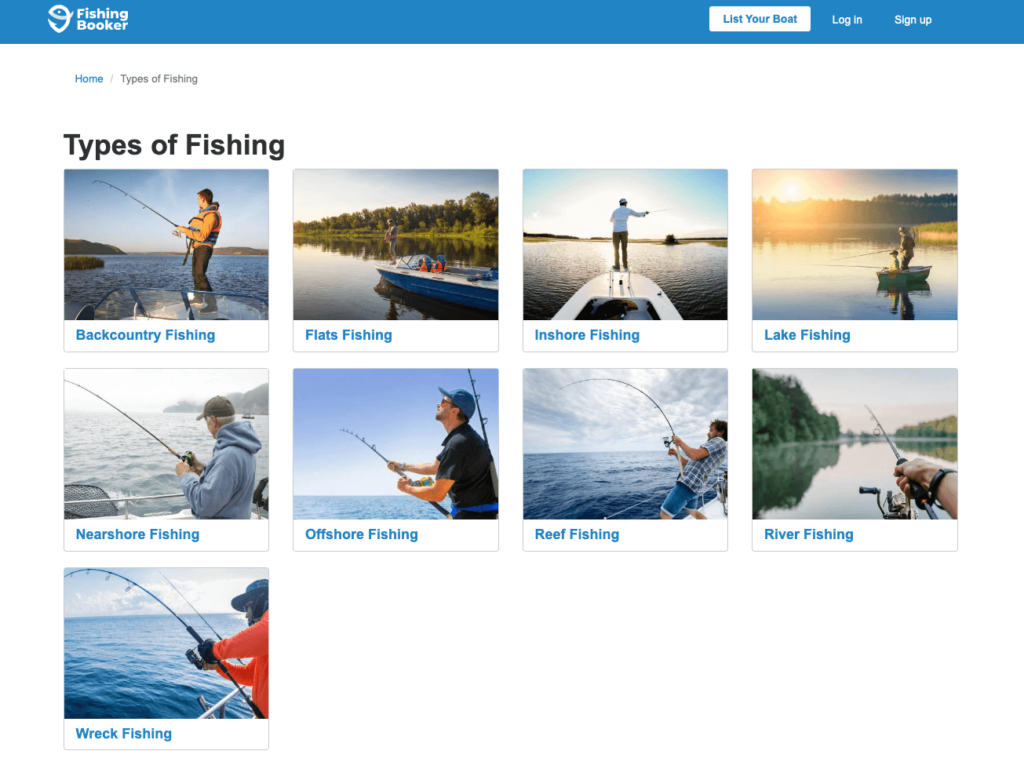
This page does not have unique content and will not rank for anything. I can confirm this by putting it into Ahrefs Site Explorer.
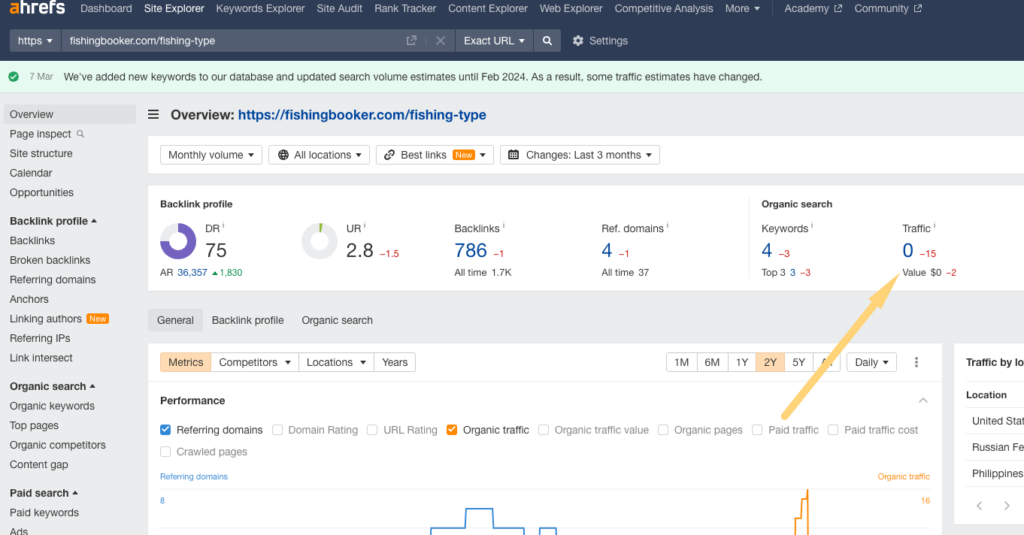
This makes an excellent choice for a guest post.
(For the SEOs yelling at the computer that their current post is a navigational hub, I would challenge that this post can still have dual value with some unique copy. I would argue that a blog post can also serve as a navigational hub. Lastly, the SERP seems to favor blog posts for this query, as evidenced by the top-ranking post.)
The last thing you must do is confirm the traffic potential and value. You can click on the keyword within the Content Gap, or we can return to Keywords Explorer and plug in the keyword.
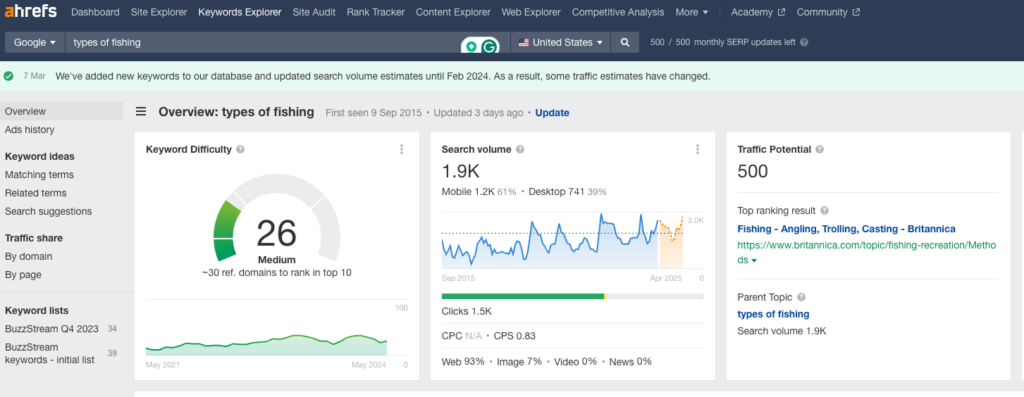
Let’s scroll down to see the SERP again. We are looking for the relevant post’s traffic potential and traffic value.
In this case, I will skip britannica.com because it’s not likely Fishingbooker.com can outrank them (their DR is much higher). So, I’ll look at the 2nd ranking post, which has a traffic potential of 519 monthly searches and a value of $123.
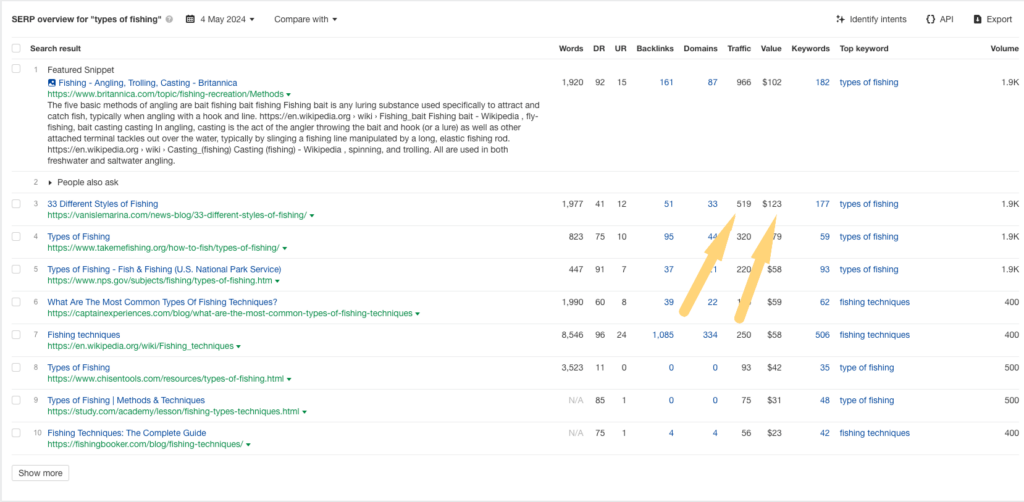
Now, I can jump down to Step 6 and draft my email.
If you have trouble finding potential keywords, you can use Google to attract more competitors, which I’ll outline next.
Find More SERP Competitors With Google
Typically, a simple Google search for a similar query can find more competitors than Ahrefs’ Organic Competitors tool.
I can start by Googling a keyword our target site already ranks for to uncover other competitors.
For example, looking at the top organic keywords for our target site, I see that they rank for “best catfish bait.”
So, let’s Google that and see if we find any new organic competitors.
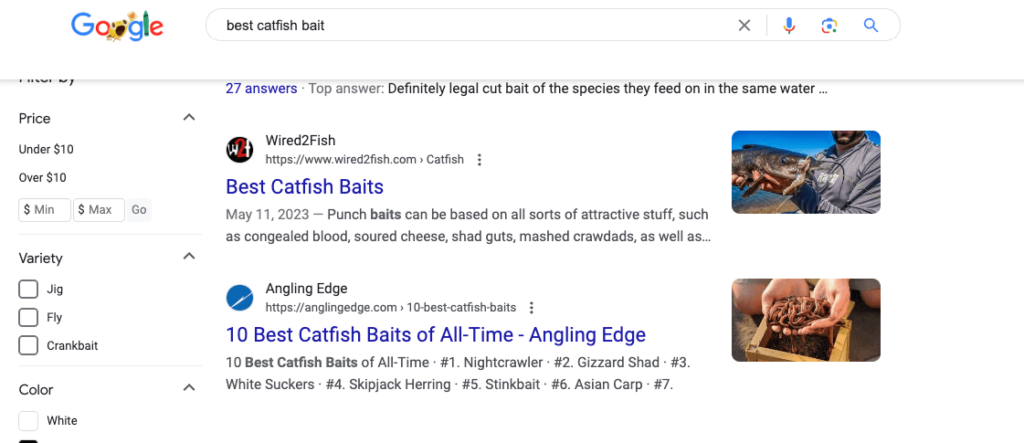
Here, I see Wired2Fish and Angling Edge.
I can add them to my existing Content Gap search or start a new analysis.
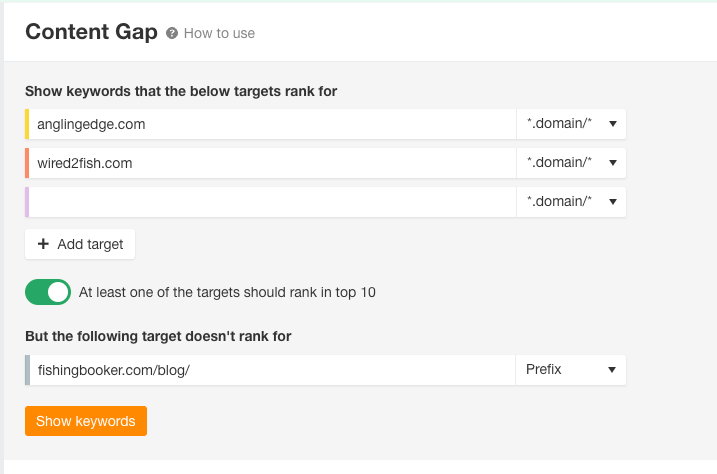
Looking through the results, I see many “best” types of posts, which can be incredibly valuable if you are an expert in the field.
For example, I see “best fishing line.”
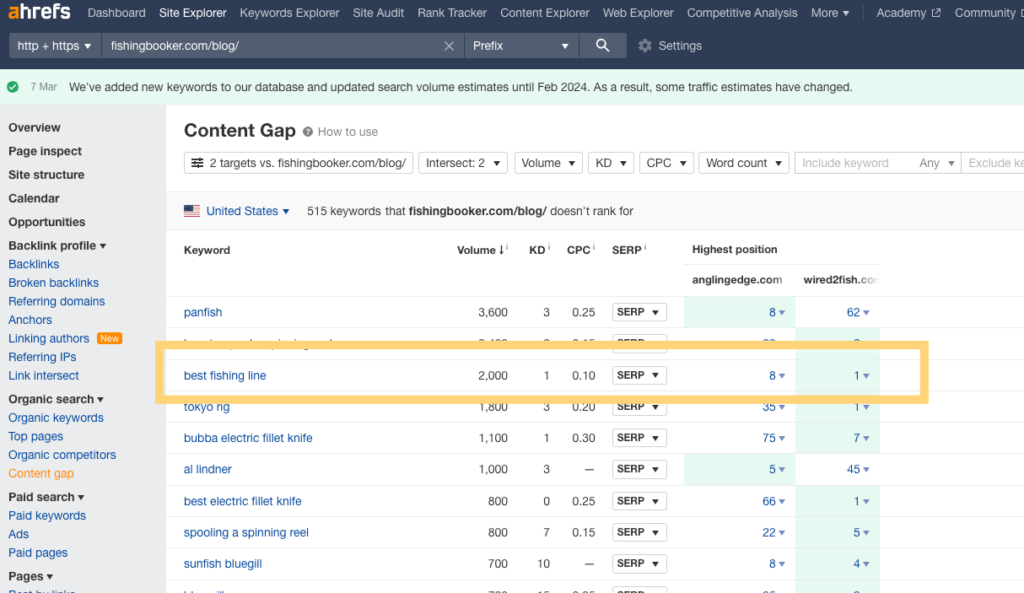
Let’s focus on this as our guest post idea because 2,000 monthly searches will make it valuable to them.
Jump down to Step 6 if you’re ready to draft the email.
What About Non-Keyword-Driven Guest Blogging?
A non-keyword-driven approach may work if you have something else to offer, such as an extensive social following or distribution network to bring traffic to your target site.
For example, we sometimes proactively find guest authors who are industry experts and well-known. We get valuable information from them to give to our readers and hope that BuzzStream reaches new audiences through their network.
But if you are at the point where you have a big enough audience or industry recognition, you probably don’t need guest posting to build your brand.
(I know what you are thinking, and we never accept unsolicited guest post pitches.)
Step 4: Identify the Correct Contact
Now that you have your list of sites and topics, you want to find the correct person to receive your guest blog pitch.
The sites that accept guest posts will tell you exactly who to address your email to.
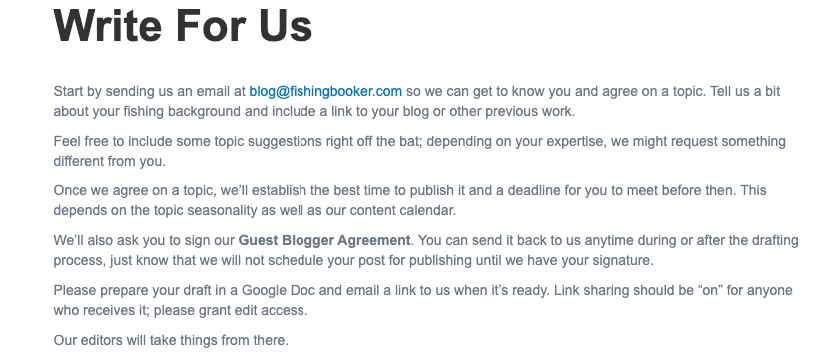
But let’s continue pretending fishingbooker.com doesn’t overtly accept guest posts.
For the sites that do not overtly accept guest posts, you may have to dig to find the correct person. These are the kinds of roles you are looking for:
- Director of Content Marketing
- Marketing Director
- Communications Director
You can start by looking at the target site’s About or Contact page, which often lists the team members.
If you can’t find it there, you can move to LinkedIn. Search for the company and choose the “People” tab.
Then, look for similar roles. For FishingBooker.com, Jacqueline R. is the Head of Content Marketing & Communications.
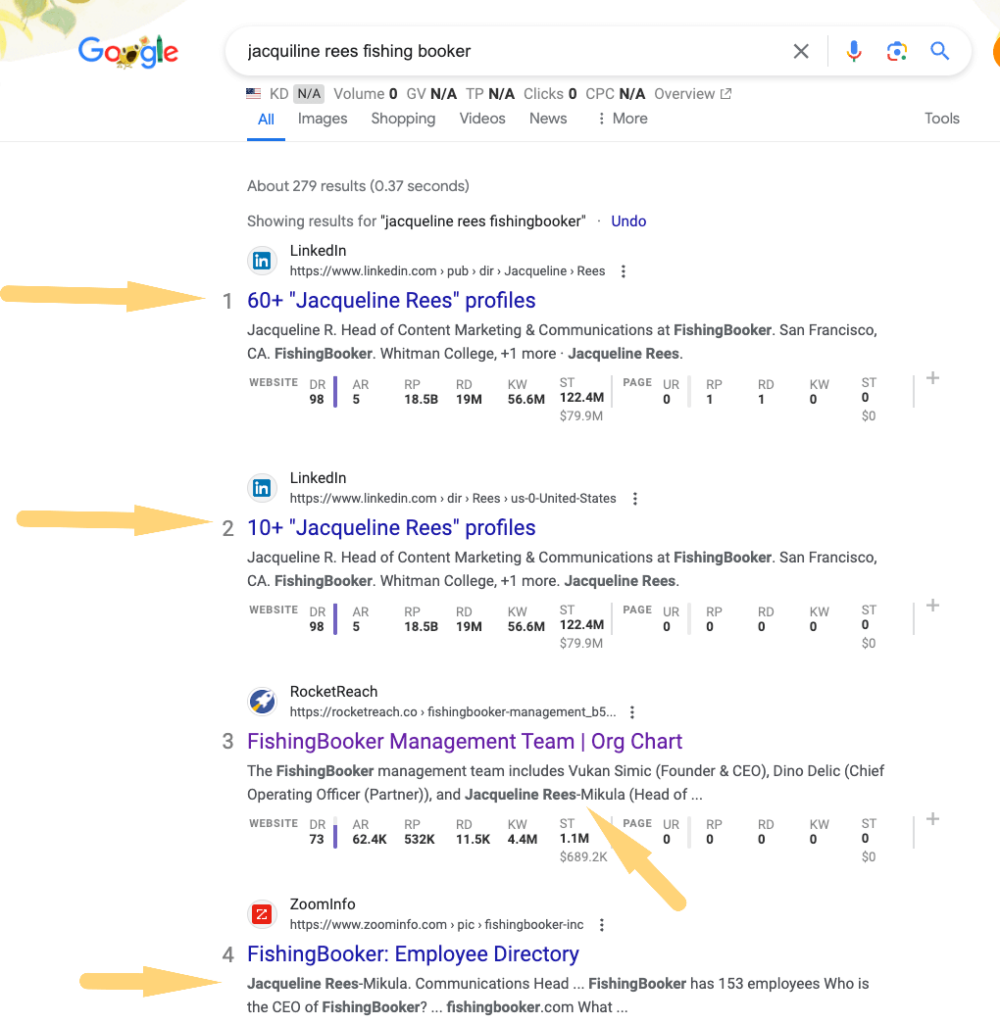
Once you find the correct person, you’ll need their email.
Step 5: Find Their Email Address
To find contact info for your prospects, you can fall back on the tactics in our trusty guide for finding anyone’s email address.
Here are a few quick tips.
Finding Email Addresses with BuzzStream
As previously mentioned, BuzzStream will pull all email addresses it finds on the site.
For example, I looked at one of the sites on my list, Fishidy, and pulled in info@fishidy.com.
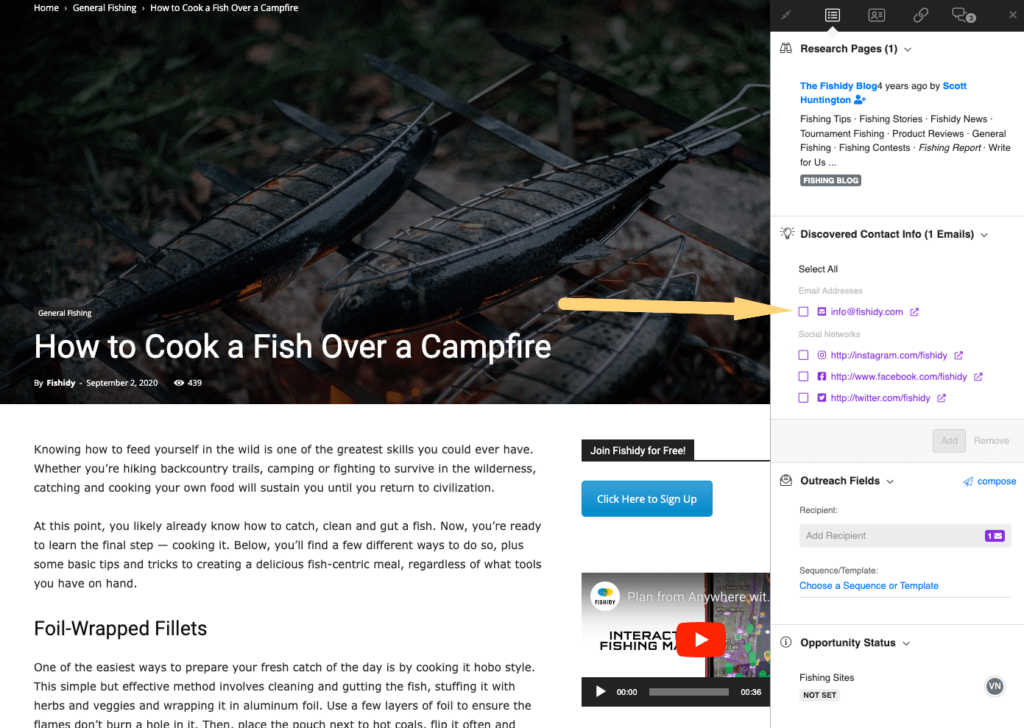
But sometimes, email addresses aren’t accessible.
For example, on FishingBooker.com, BuzzStream didn’t find any email contact information because there was none on the site.
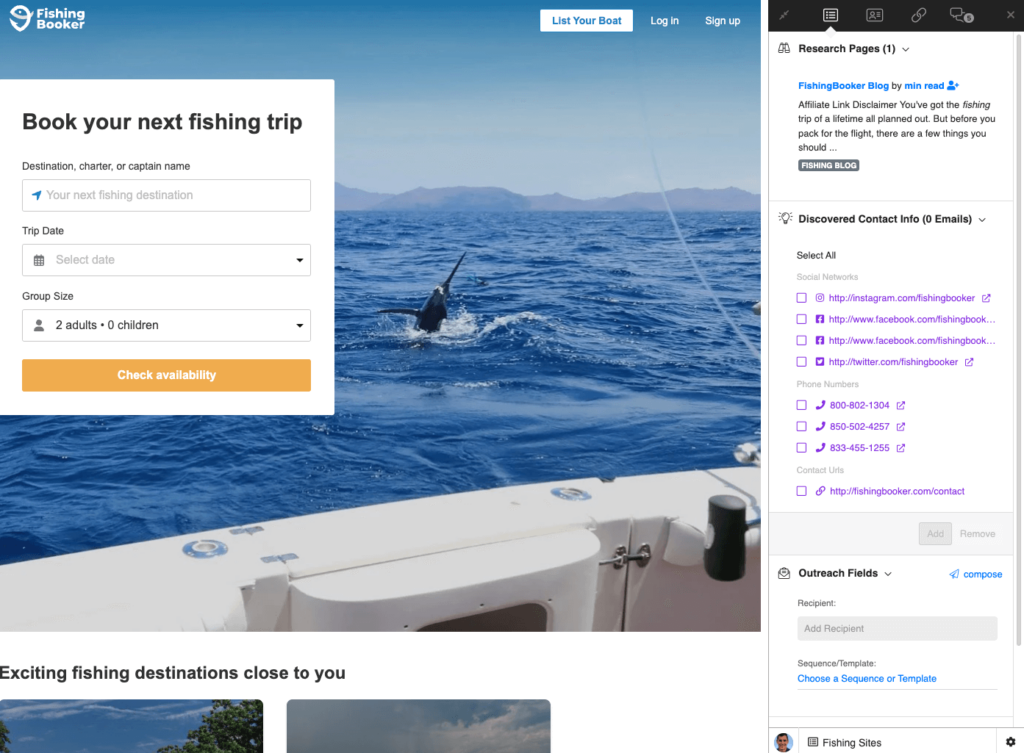
In these cases, you might have to turn to Google.
Finding Email Addresses with Google
First, I can Google the person’s name + “email” or “contact.”
Unfortunately, we don’t know Jacqueline’s last name yet, which would make Googling a bit easier.
But we can find that out with Google as well!
Let’s start with Jacqueline R. Fishing Booker. Immediately, I found her last name, Rees, or rather Rees-Mikula.
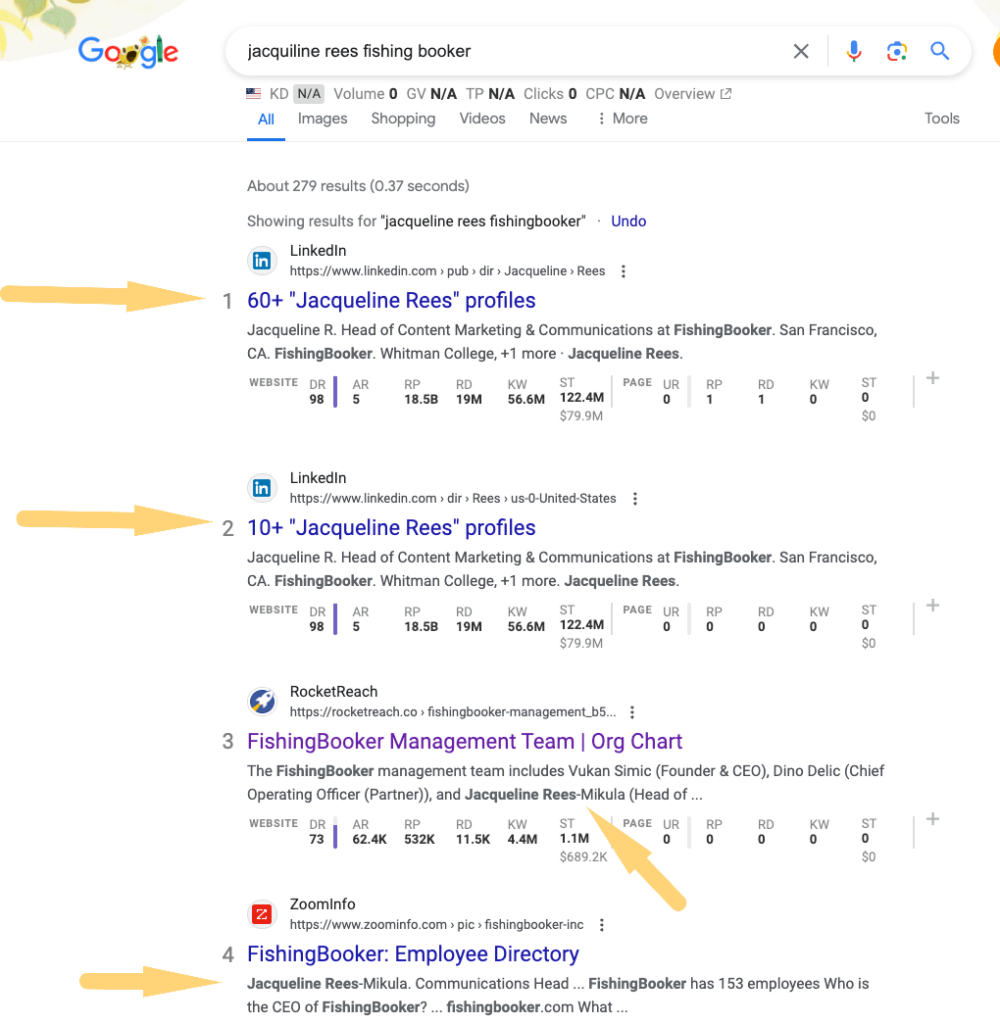
So, I can now continue to search for Jacqueline Rees-Mikula Fishing Booker + email.
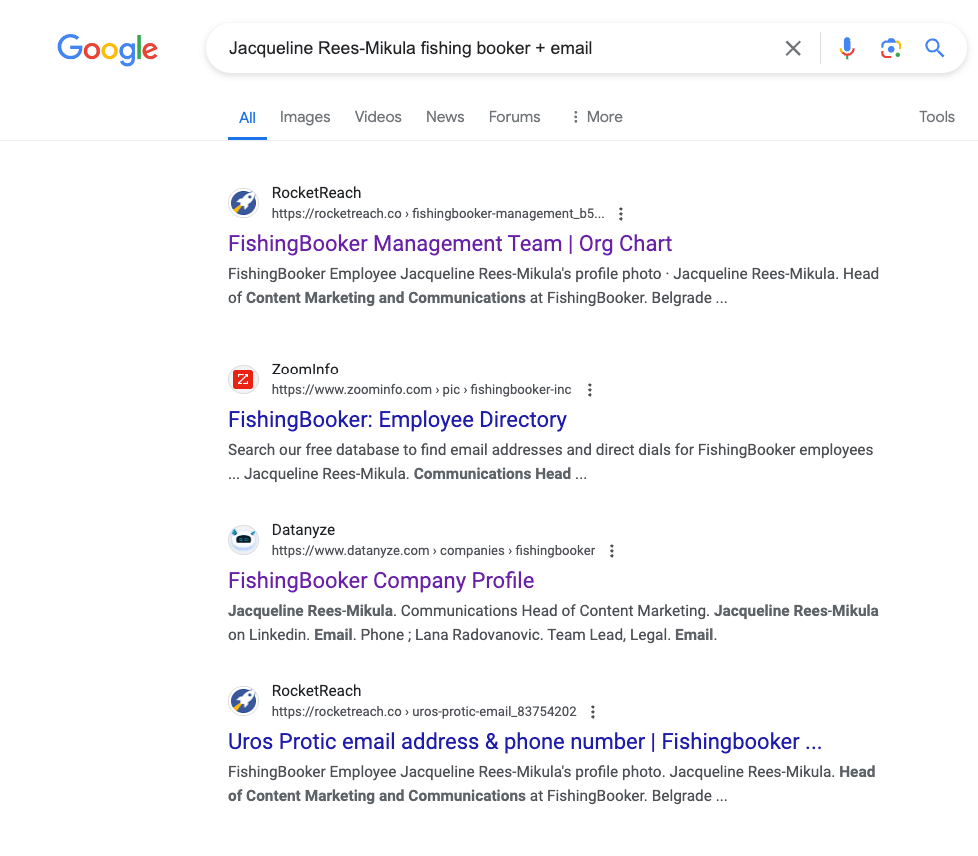
Unfortunately, nothing is popping out to me.
But wait, I know she’s on LinkedIn, so I can take a shortcut using a Chrome extension.
Finding Email Addresses with LinkedIn
Several Chrome extensions can help cross-check LinkedIn profiles with email addresses. For example, I can check Jacqueline’s email address if I use RocketReach (which allows for 5 free lookups).
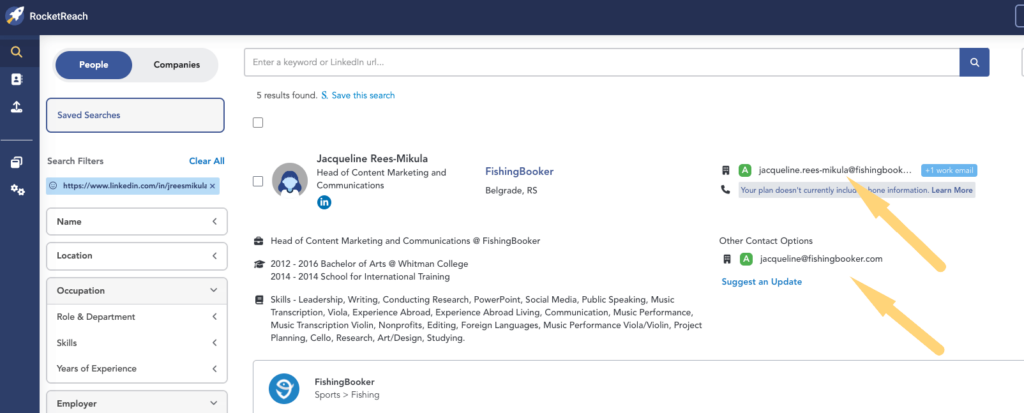
I want to verify the email I found to be entirely sure before heading to Step 6 and drafting my email.
Email Verification with Hunter
You’d want to verify an email address for several reasons, but the biggest is that sending too many undeliverable emails can hurt your sender’s reputation.
Sender reputation is essential these days with Google’s new email requirements.
Hunter allows free email verifications, which also provide a confidence score.

Once you know that it’s valid, you can start drafting.
Updating Contacts in BuzzStream
Before I draft, I want to circle back to my list.
Now that I’ve found Jacqueline’s email, I’ll manually enter it into BuzzStream.
I’ll do this by clicking on FishingBooker in my Outreach List, then clicking Add under People.
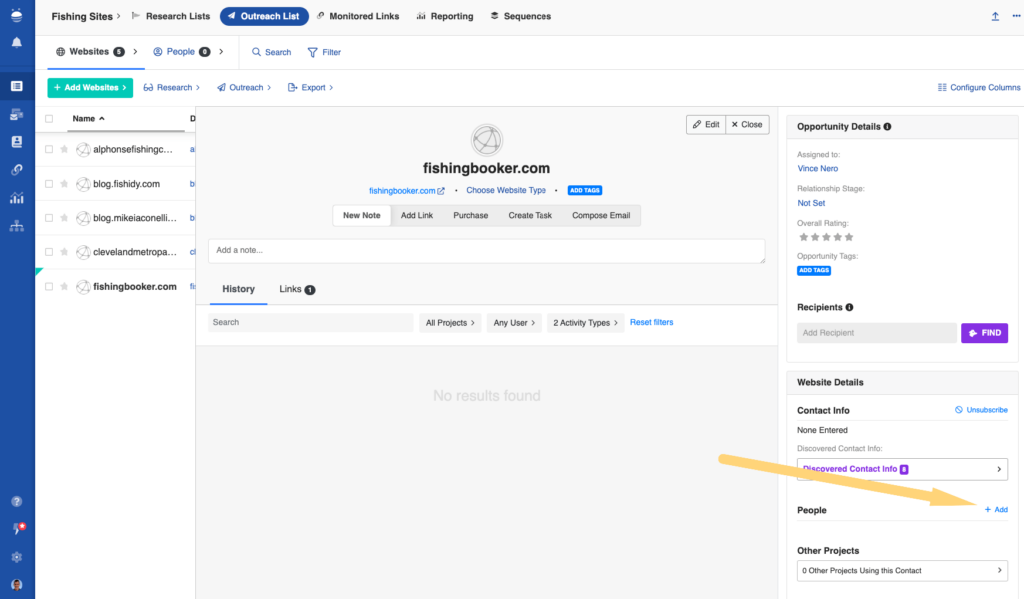
I can now add Jacqueline’s name and email, which will help me in the next section.
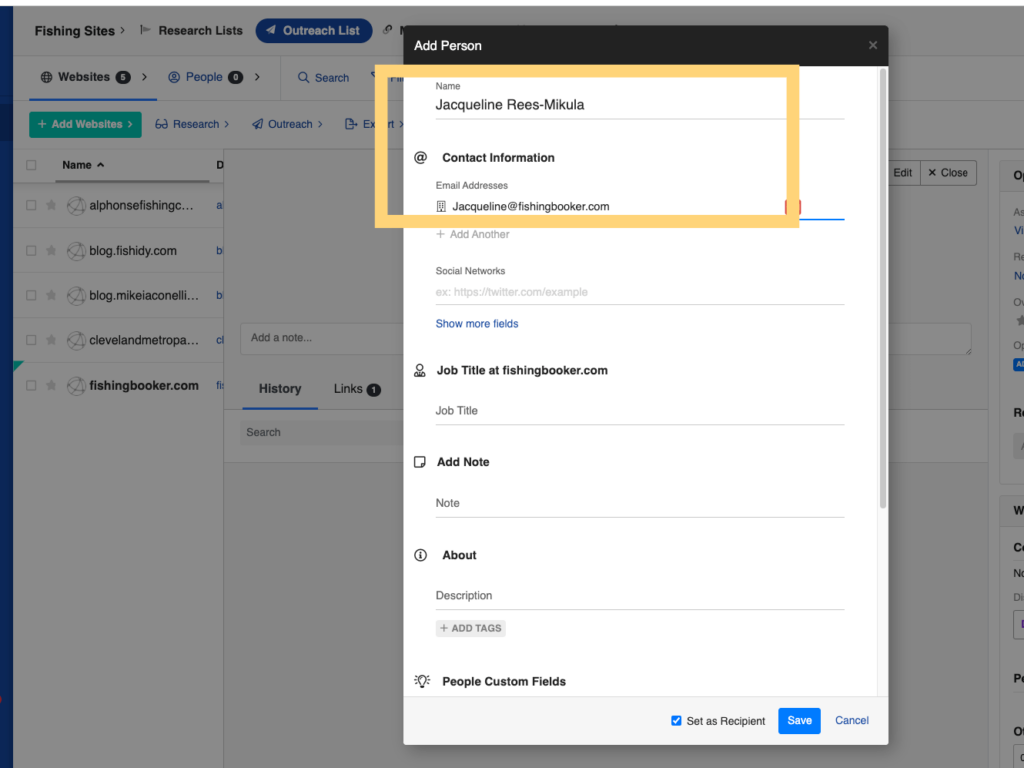
Alternatively, instead of going through the BuzzStream Database, I could just navigate to FishingBooker.com and use the Buzzmarker Chrome Extension to add any new contact information to the page quickly.
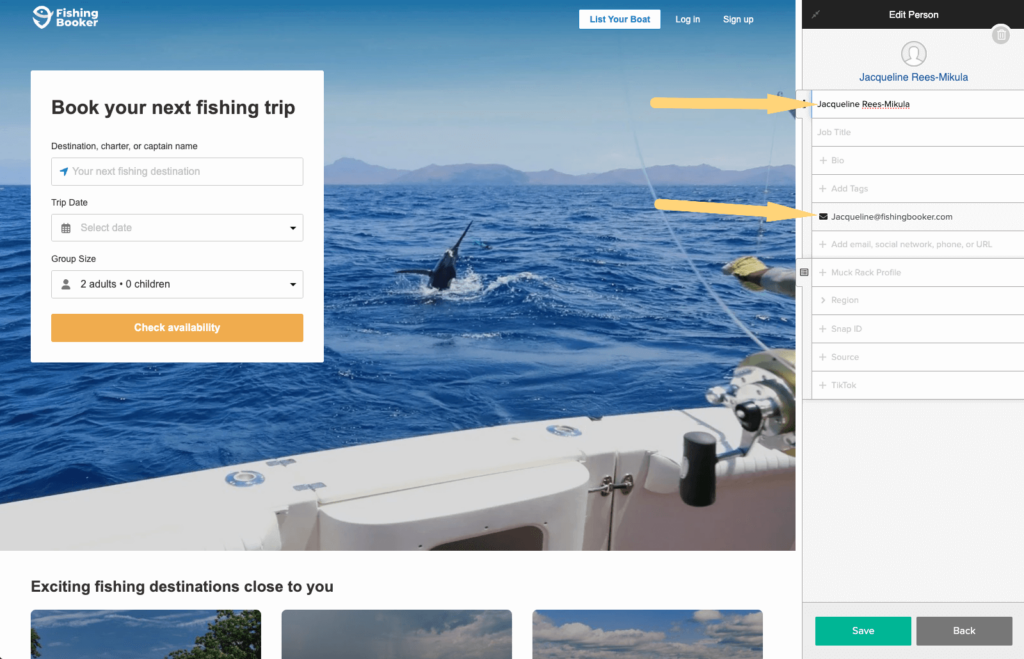
Now, it’s time to email your targets.
Step 6: Draft Your Email
Your pitch for guest posting is very straightforward, which we cover in our email template post.
The pitch includes an introduction, previous guest posts you have written, and, most importantly, the value they will get from ranking for said keyword.
In our scenario, the focus should be that the target audience is missing out on a keyword their competitor is ranking for.
So your template would look something like this:
Hi [First Name],
I just read [Research Page Title] and particularly enjoyed [personalize].
I work for [company] and noticed that your site doesn’t rank for [keyword] while your competitor [competitor site name] does. [keyword] has the potential to bring in [number] monthly visits to your site and has a traffic value of about [traffic value].
If you’re interested, I can write this article for you. I’m [why you’re qualified to write].
Here’s an example of how I helped get [Site/Brand] to rank for [target keyword] here [link].
To be completely transparent, I’d also like to include a link to [Your site] completely naturally within the article.
I’d love to hear your thoughts about the post idea. If these don’t work for you, I’m happy to pitch more ideas.
–
Not everyone will agree, but it’s important to be upfront and tell them you are looking for a link.
Most will get the game, and as long as your writing examples are good enough and your case is strong enough, you will be OK.
Also, note that this template calls out the target keyword, traffic potential, and traffic value. This is where we are going to stand out from the competition.
As mentioned, I receive 3-5 guest post pitches each day. None of them have ever used this tactic.
Why? Because it takes a little extra effort. But that’s how you can cut through the noise.
What if You Haven’t Written Any Guest Posts?
This is a common question, and it’s reasonable. Five or six years ago, I was in the same boat! (Fishing pun: engaged. And don’t worry, there’s more to come.)
If you haven’t written guest posts, that’s OK; you may have to start on smaller, newer, lower-authority sites.
You’ll need to provide writing examples 95% of the time. I recommend finding a site where I can get some writing published. The generic “write for us” sites are great for these purposes.
Without any previous guest posts, your pitch should call out anything you’ve written:
Hi [First Name],
I just read [Research Page Title] and particularly enjoyed [personalize].
I write for [Your site] and noticed that your site doesn’t rank for [keyword] while your competitor [competitor site name] does. [keyword] has the potential to bring in [number] monthly visits to your site and has a traffic value of about [traffic value].
If you’re interested, I can write this article for you. I’m [why you’re qualified to write].
To be completely transparent, I’d also like to include a link to [Your site] completely naturally within the article.
I’d love to hear your thoughts. If this post idea doesn’t work for you, I’m happy to pitch more ideas.
Thanks,
If you’re feeling ambitious, you can write an entire article for them without getting their approval and take your chances that they’ll want it.
That will really hook them (pun!).
Hi [First Name],
I just read [Research Page Title] and particularly enjoyed [personalize].
I write for [Your site] and noticed that your site doesn’t rank for [keyword] while your competitor [competitor site name] does. [keyword] has the potential to bring in [number] monthly visits to your site and has a traffic value of about [traffic value].
I’ve taken the liberty of writing this post for you. You can see it here: [link].
To be completely transparent, you’ll see that I’ve included a link to [Your site] completely naturally within the article.
I’d love to hear your thoughts on including this in your blog.
Thanks,
Drafting and Sending Email in BuzzStream
In BuzzStream, I can use my previous list to begin drafting my emails.
If I toggle through to the Outreach List, I’ll see all the sites I approved during my prospecting/quality evaluation phase.
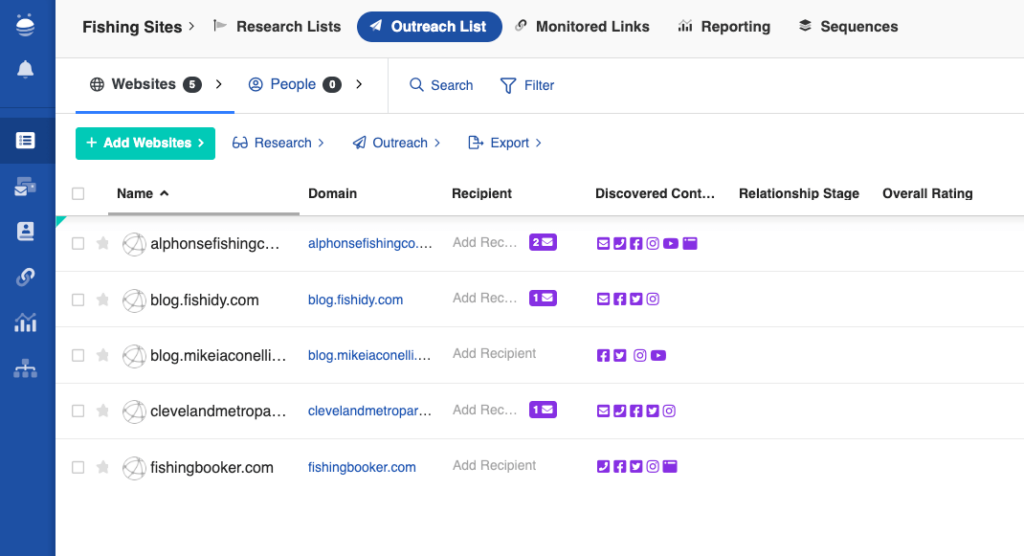
I can see all of the contact information that BuzzStream has found, making it less necessary for me to spend time in Step 5 digging for some emails.
When writing an email, I can select all the sites I want to contact and choose “Send Individually” from the Outreach dropdown.
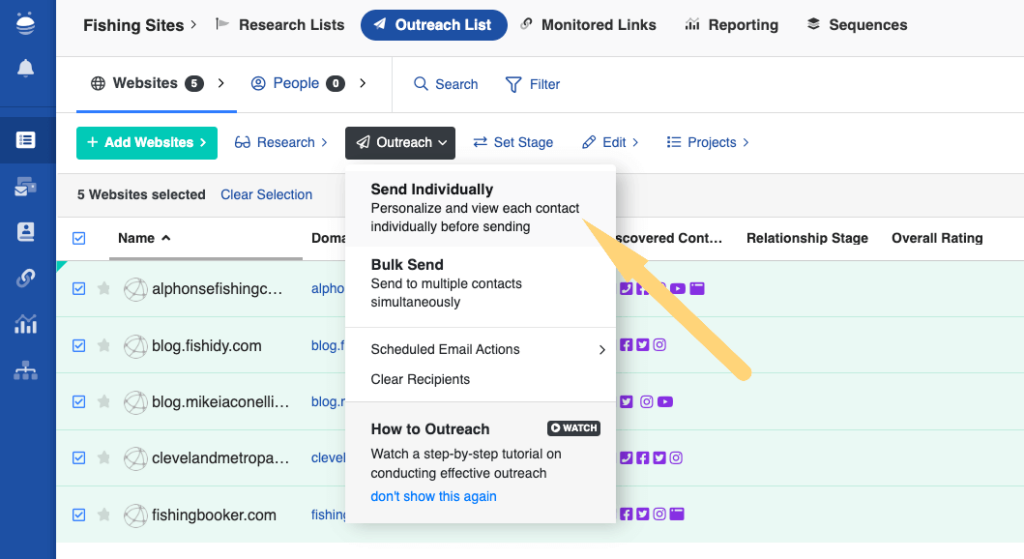
Next, it will prompt me to choose a Sequence or Template. I choose Create New and paste my template.
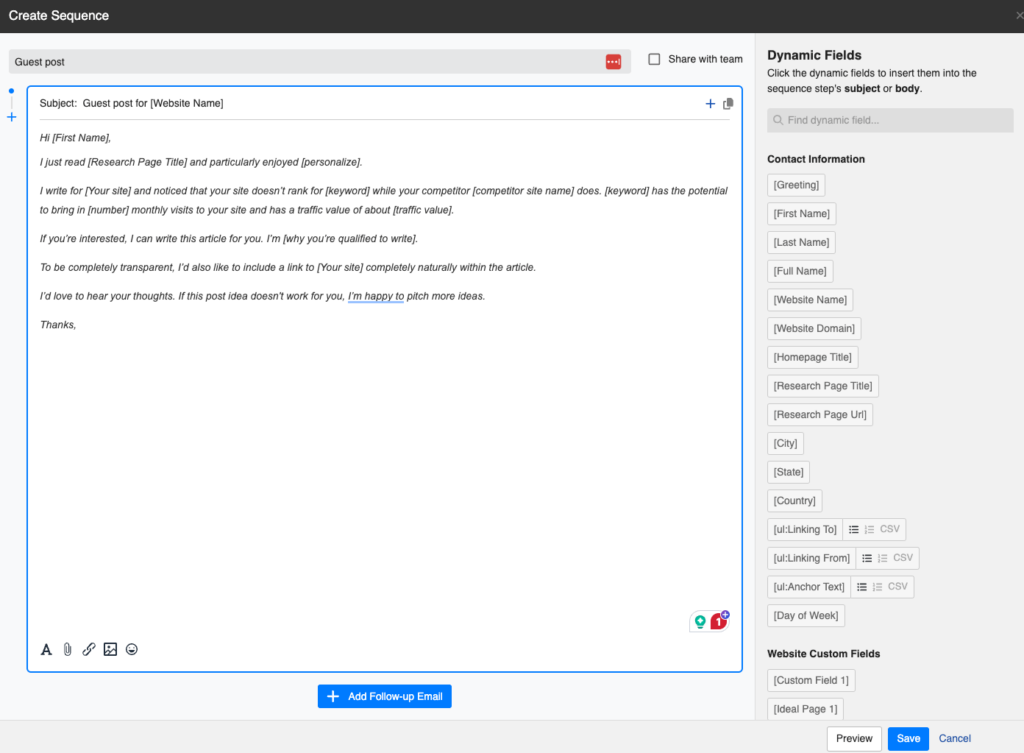
Next, I’ll create a quick follow-up email by pressing Add Follow-up Email. This will automatically follow up if my contact doesn’t reach out.
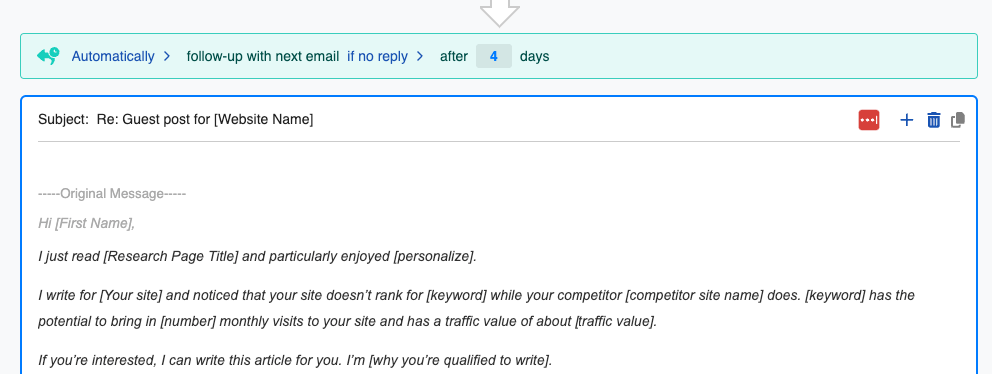
Once the template is set, I’ll be taken to the Outreach flow. I see the email on the right, with all fields merged onto it.
Then, on the left, I see all of my team’s contact history with my target site.
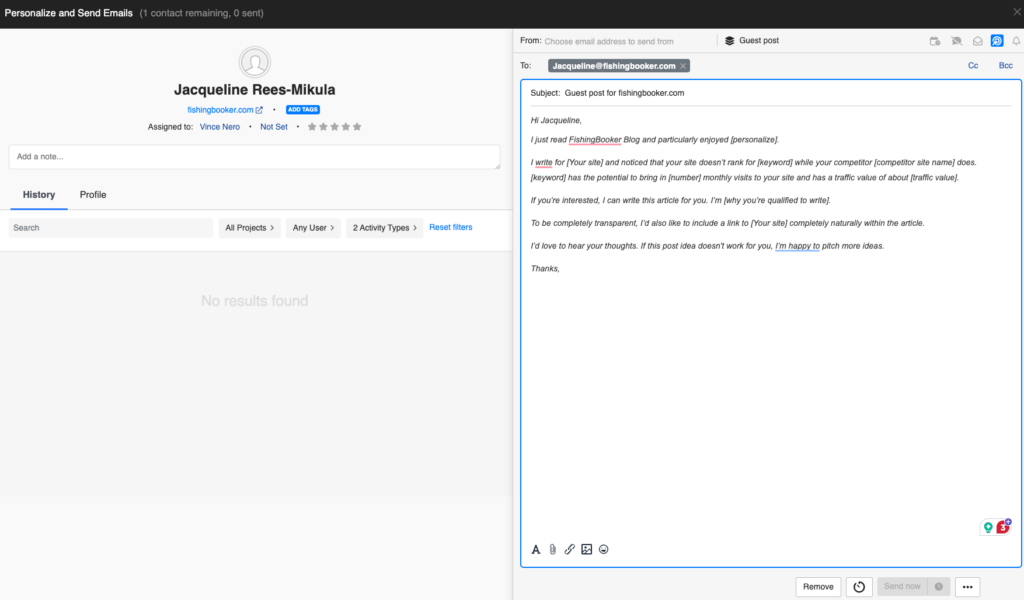
Once I send my emails, I’ll see the status and any replies within BuzzStream. Then I can continue the conversation and hopefully start writing my posts.
Step 7: Write a Great Post
If your guest post idea is accepted, all that’s left is to write a fantastic post. This isn’t a post about writing great content, but I do have some integral tips:
Make Sure Your Content is Helpful
The golden rule for guest posting is this: your post should be the same quality as what you would want on your own site.
In Step 2, I previously linked to my Helpful Content evaluation checklist for evaluating your target site. The checklist was modeled after Google’s content self-assessment post.
So, when writing your post, follow the same guidelines if you want your backlink to provide value.
Include Your Link Naturally
Some sites will include your link in an author bio section. Remember that Ahrefs post?
Here’s where my link was included:
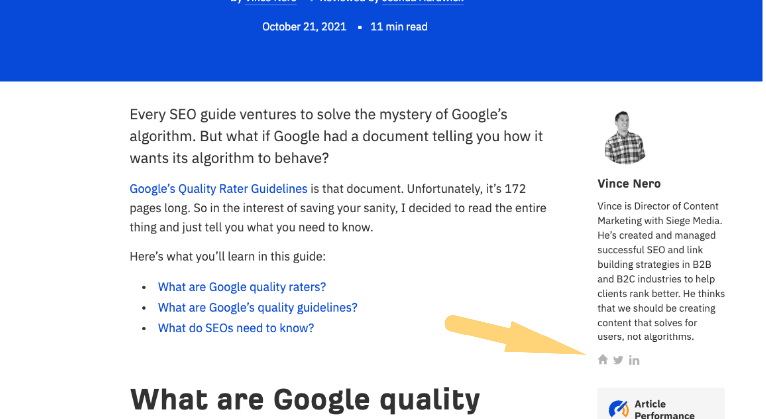
Others may not take this approach, so you must naturally weave your link into your site. Linking to a product page is rarely natural. Instead, I recommend linking to either a blog post or your homepage.
Either way, you do it naturally.
Avoid exact match keywords because those stick out like a sore thumb and could be seen as spammy.
You can get enough value from a backlink even if you don’t use exact match keywords. We chatted about internal linking with Positional’s CEO, Nate Matherson.
He essentially showed that with this approach, as long as your website’s internal linking is configured correctly, you could see gains of up to 20-30% in organic traffic.
Is Guest Blogging Risky?
According to Google, paid guest posts must have rel= “nofollow” and “sponsored” tags, which effectively render the links nonexistent for SEO purposes.
In fact, after a now-deleted conversation on X with John Mueller in 2020, it was clear that essentially devalues links from guest posts because they are “unnatural.”
“The part that’s problematic is the links — if you’re providing the content/the links, then those links shouldn’t be passing signals & should have the rel-sponsored / rel-nofollow attached. It’s fine to see it as a way of reaching a broader audience.”
He then confirmed that this even applies to links in the author contributor area.
(You can read the whole saga on Search Engine Journal.)
So, what most people did was remove author contributor links.
Is that enough to convince Google that it’s not a paid placement?
Google has also discussed how it uses its AI-based spam prevention tool, SpamBrain, to find sites that are buying and selling links.
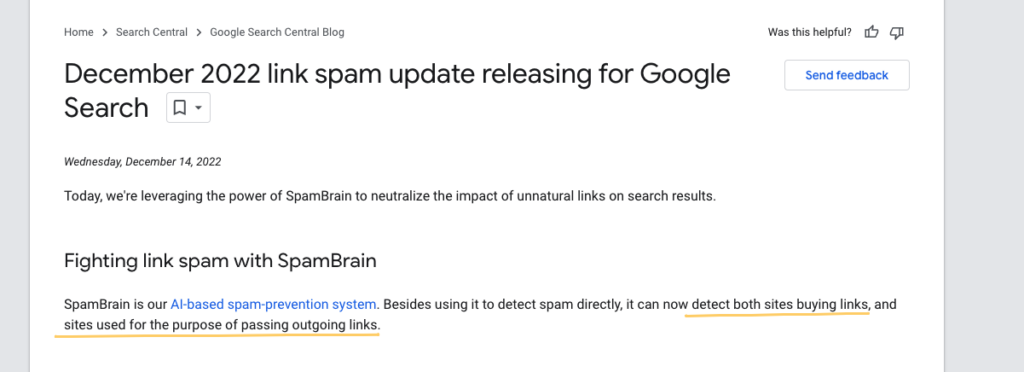
So, chances are they are a little smarter than that.
With any link building strategy, it’s essential to diversify your tactics. Leaning into any one piece will get you into trouble.
If all your links are from guest post sites, that will get you into trouble—especially if you pay for them.
My approach helps to alleviate this risk in a big way, but you should still always want to diversify how and when you build your links.
Too many links in a short period is an unnatural signal to Google.
Google will continue to look for sites that buy and sell link placements, so as SEOs and content marketers, we must always be able to adjust our strategies.
If your goal is to scale and spray hundreds of emails to catch one site, that’s not the way to do it.
However, if you look at guest posting as if you are providing valuable information for your target sites, you will have success.

 End-to-end outreach workflow
End-to-end outreach workflow



 Check out the BuzzStream Podcast
Check out the BuzzStream Podcast







